
Investigating a possible link between the cold murder cases in the Antelope Valley of Hollywood screenwriter Gary Devore and Los Angeles County Sheriff’s Deputy Jonathan Aujay
Sprawling poppy fields, aerospace, and secret military bases, California’s Antelope Valley is known for these landmarks. Over the past decades, the Antelope Valley became more than a significant geographical 3,000 square mile region with its red rock formations and hidden canyons attractive to government weapons contractors such as Lockheed Martin, Northrop Grumman, as well as Edwards Air Force Base.
This 11,000-year-old desert basin has become a character in the untold and unsolved murder and missing person cases amidst covert federal activity and stand-offs between criminal organizations and police. It is material that has inspired crime novelists and filmmakers for decades.
In truth, some of the darker real-life scenarios of unsolved cases have yet to be fully uncovered. In 1996, a three-part expose written by the journalist Gary Webb lifted the veil on possible collusion between intelligence officers and drug dealers. The former DEA agent Cerelino Castillo went on the record that he had witnessed these exchanges. Webb’s article led to an investigation by the CIA and Department of Justice. Rather than celebrated for his contribution, Webb was eventually vilified by his peers and lost his credibility and livelihood. Years later Gary Webb was found dead with two gunshots to the head.
A year after Webb’s expose, Hollywood screenwriter Gary Devore disappeared on a balmy night in the Antelope Valley, where covert operations and clashes between drug dealers and local police were already a fixture. Not long before Devore’s body was discovered a year later, Sheriff’s Deputy Jonathan Aujay disappeared without trace in the same locale.
This feature seeks to uncover the cold murder cases of screenwriter Gary Devore, Sheriff’s Deputy Jonathan Aujay, and numerous other missing and deceased individuals in the Antelope Valley. It is based on interviews with detectives and other law enforcement officials, whistleblowers, a former convicted drug dealer, forensic deception experts, geographical profilers, and court documents. The investigation highlights a significant period marked by covert federal operations, local police scrutiny, and corruption.
If anything, what follows is a saloon ballad of the Detective who bursts through the doors in search of Lady Justice and Truth, only to discover that many of his fellow officers are engaged in covering up for both.
On the night of June 27, 1997, Gary Martin Devore, a screenwriter and avid cowboy, vanished while driving home to Santa Barbara from a writer’s stay in New Mexico. He was excited to submit his finished script, “The Big Steal,” at MGM Studios the following Monday. It would have been his directorial debut. It never happened. He vanished in the dark of night on Highway 14.
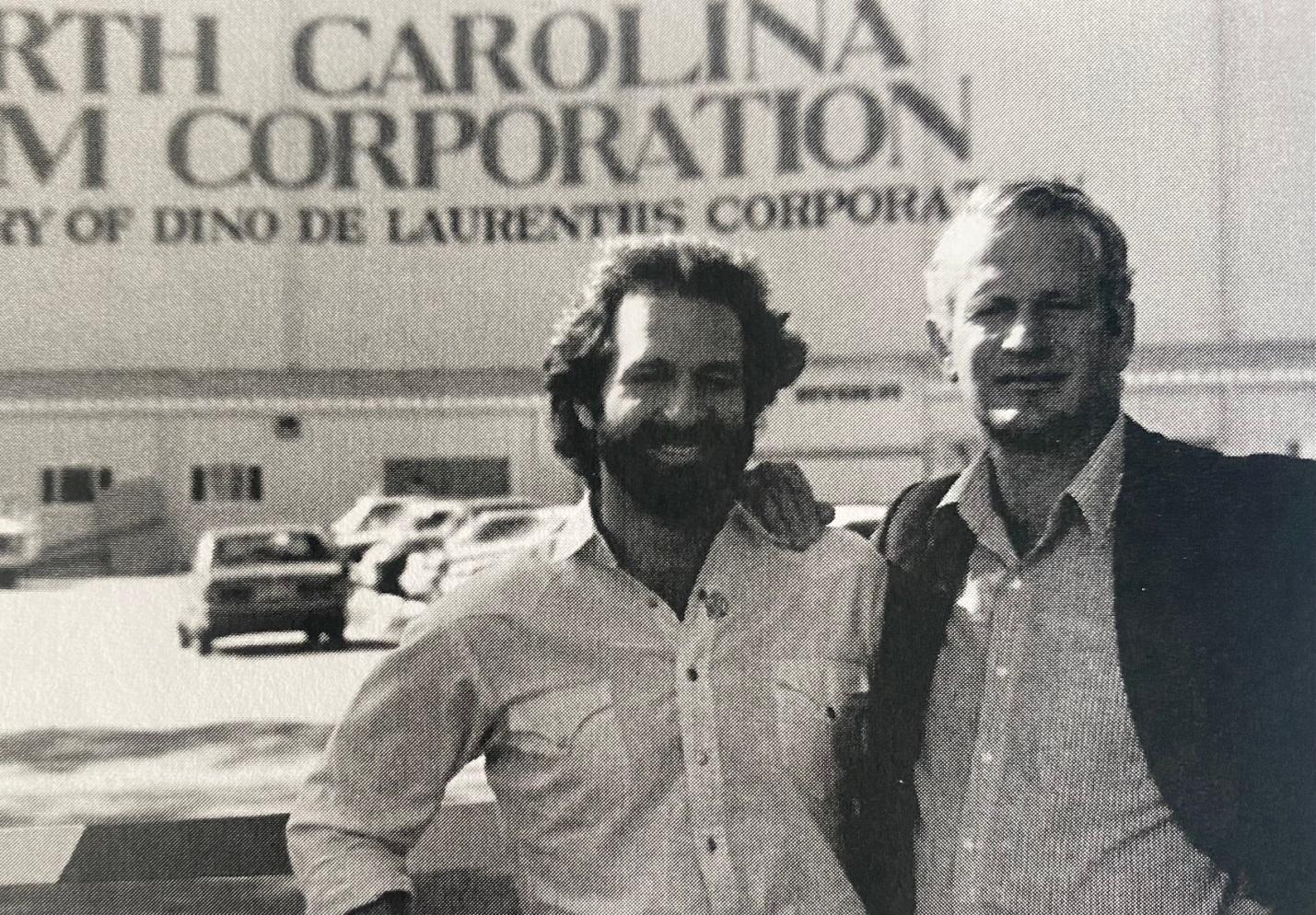
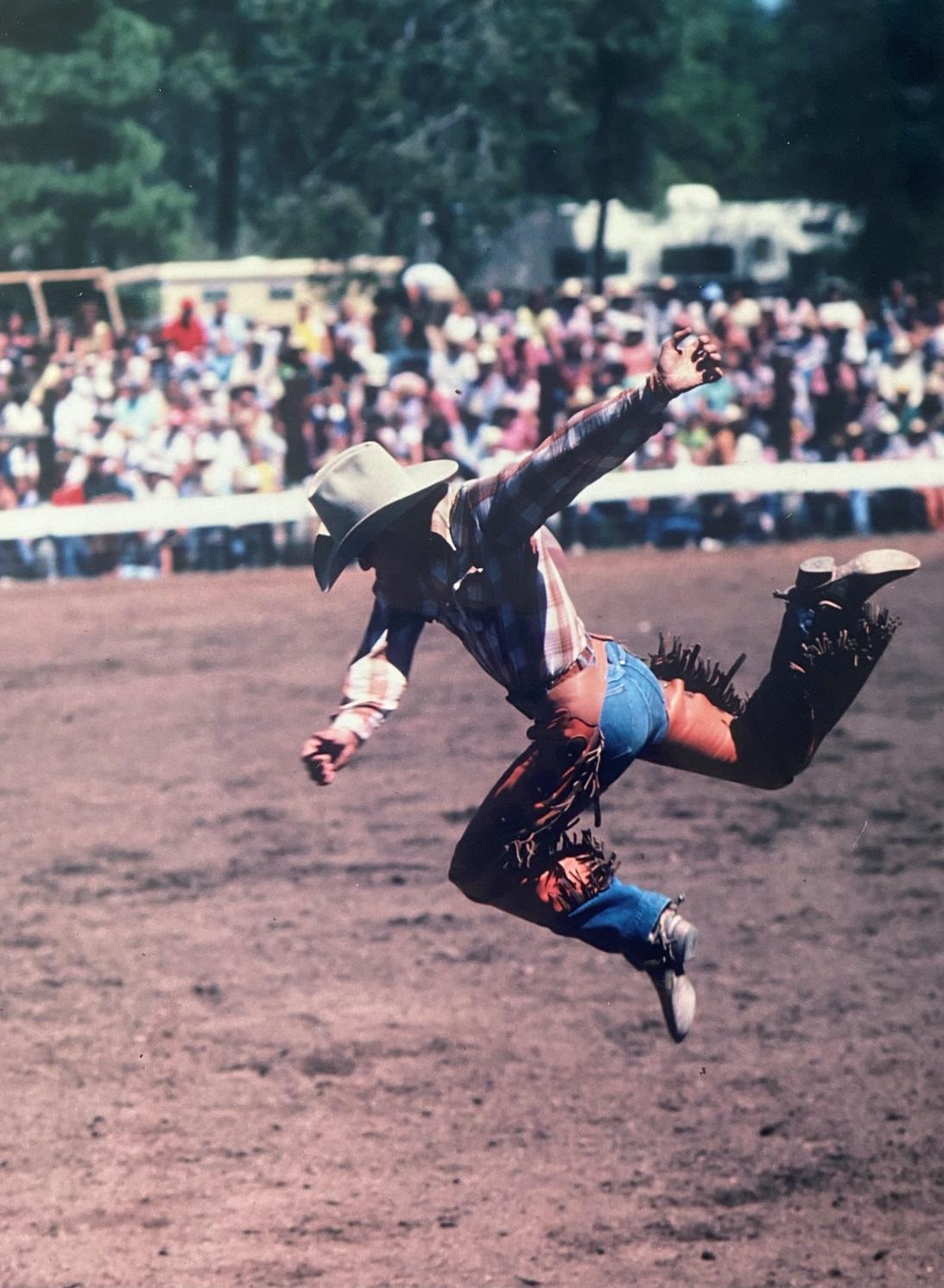
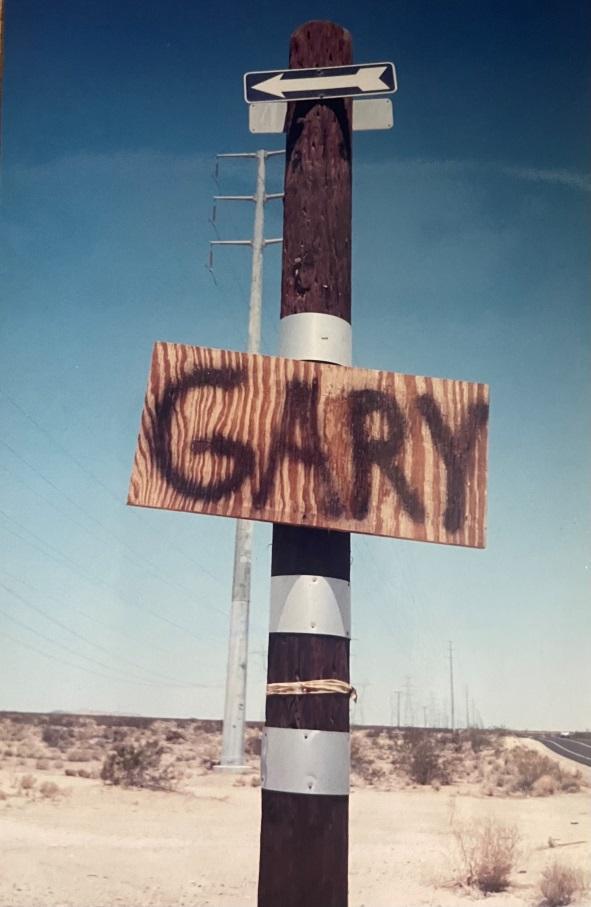
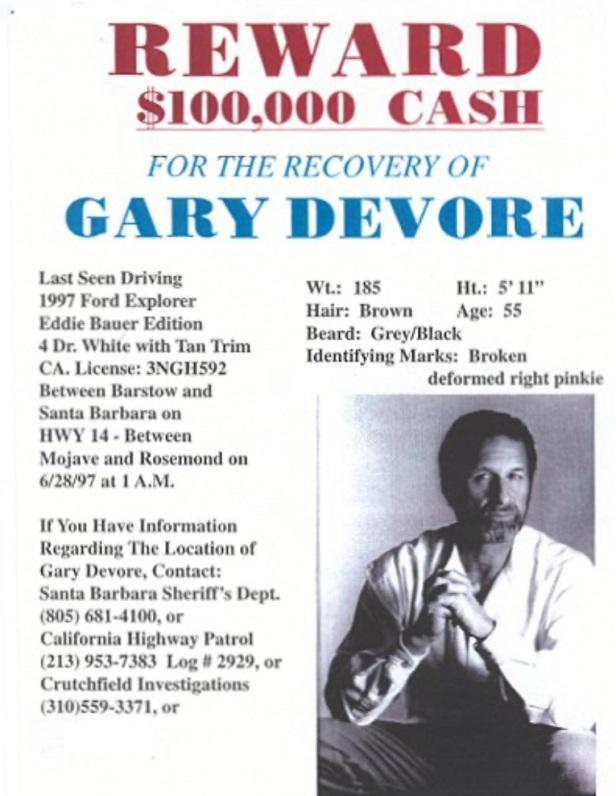
The desert area and waters were combed through by Devore’s family, his fellow cowboys of the Rancheros club, citizen volunteers, local police, and the FBI. Nothing was found.
A year later, by way of a tip, divers of the Los Angeles County Sheriff’s Department (LASD) recovered Devore’s truck and skeleton submerged in the California Aqueduct. The California Highway Patrol took the car to a tow yard for examination. There was one problem: The skeleton was handless. Hand bones were found in the back of the truck.
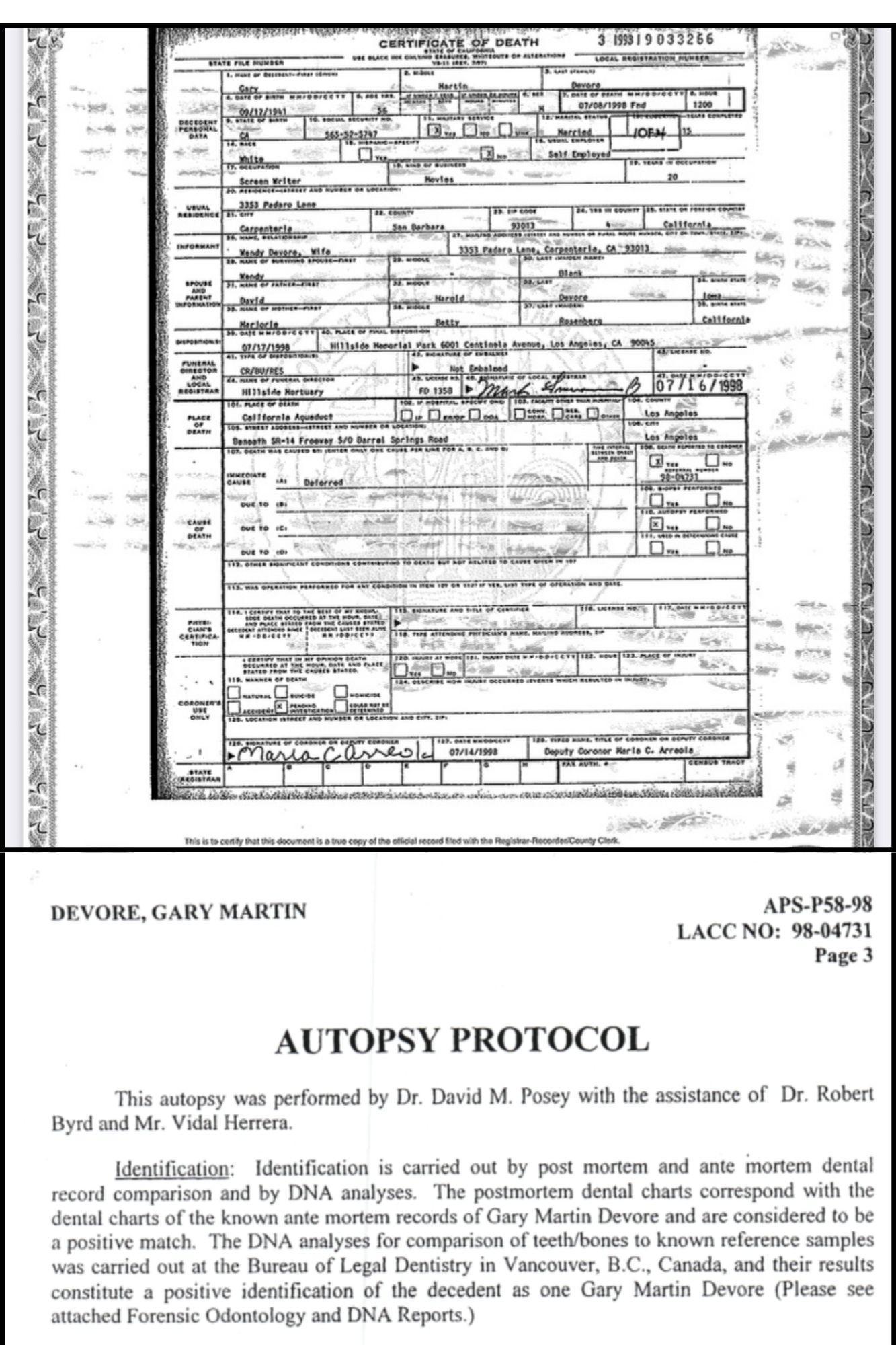
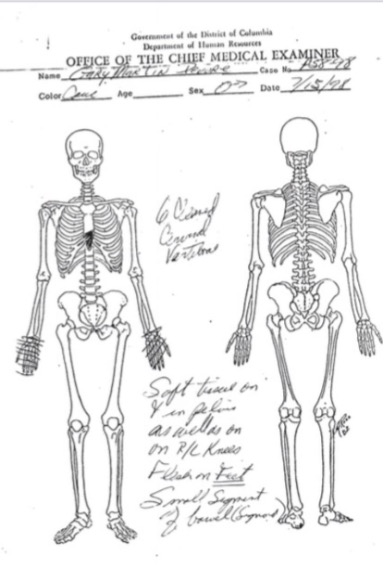
The Los Angeles County Medical Examiner could not confirm the cause or manner of death. Devore’s wife, Wendy Oates-Devore, hired an independent pathologist, Dr. David Posey, who recruited a Canadian dental expert to trace the DNA. Bones were shipped to Canada. In 1999, a film camera was used to document the evidence exhibits.
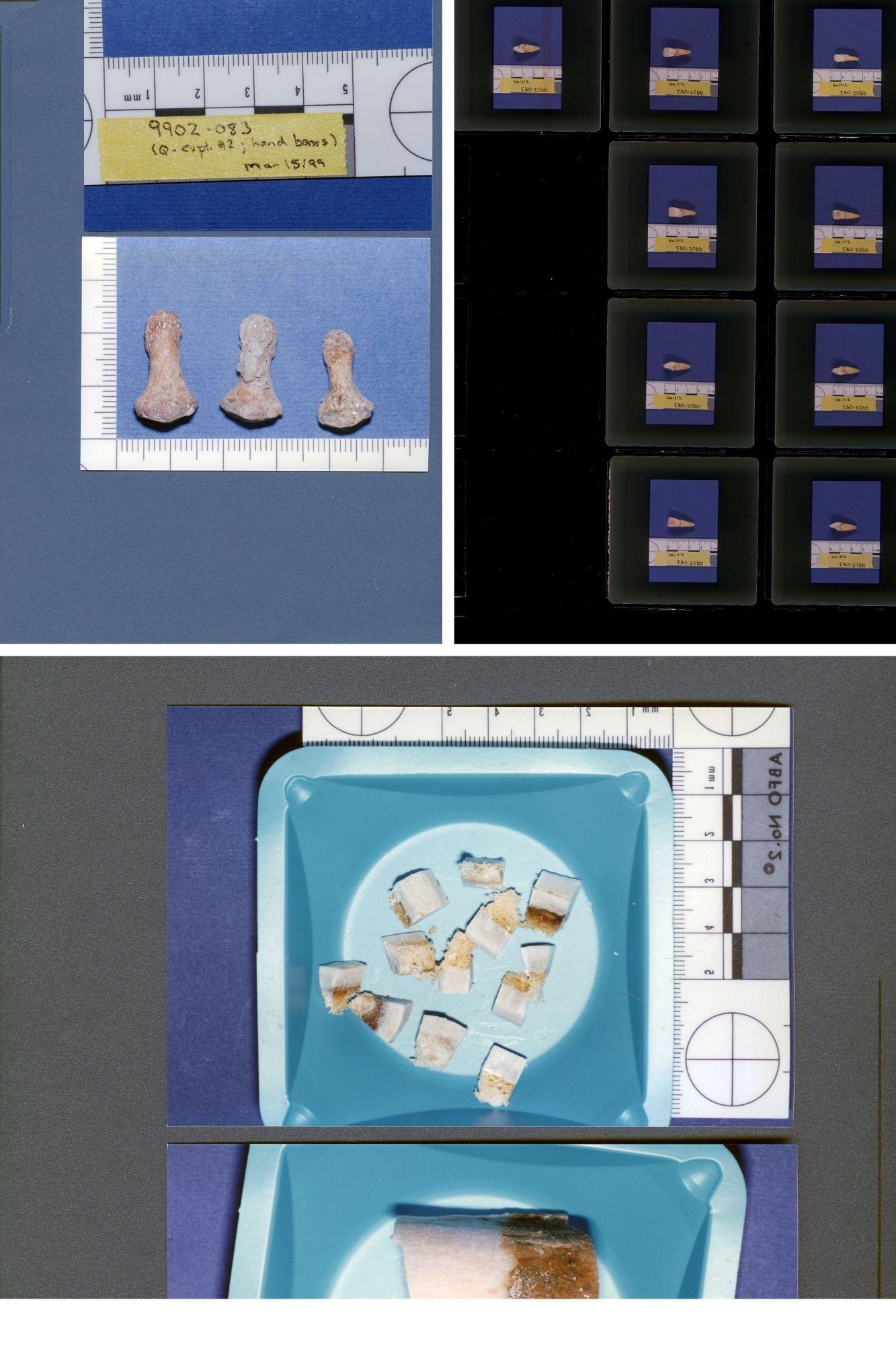
The report on dental work and DNA confirmed that the skeleton belonged to Gary Devore. But the hand bones were close to a hundred years old and perhaps not even human, according to Dr. David Sweet, a Canadian pathologist and dentist. Dr. Posey changed the cause and manner of death in the report later to undetermined but opined it was a homicide.[1]
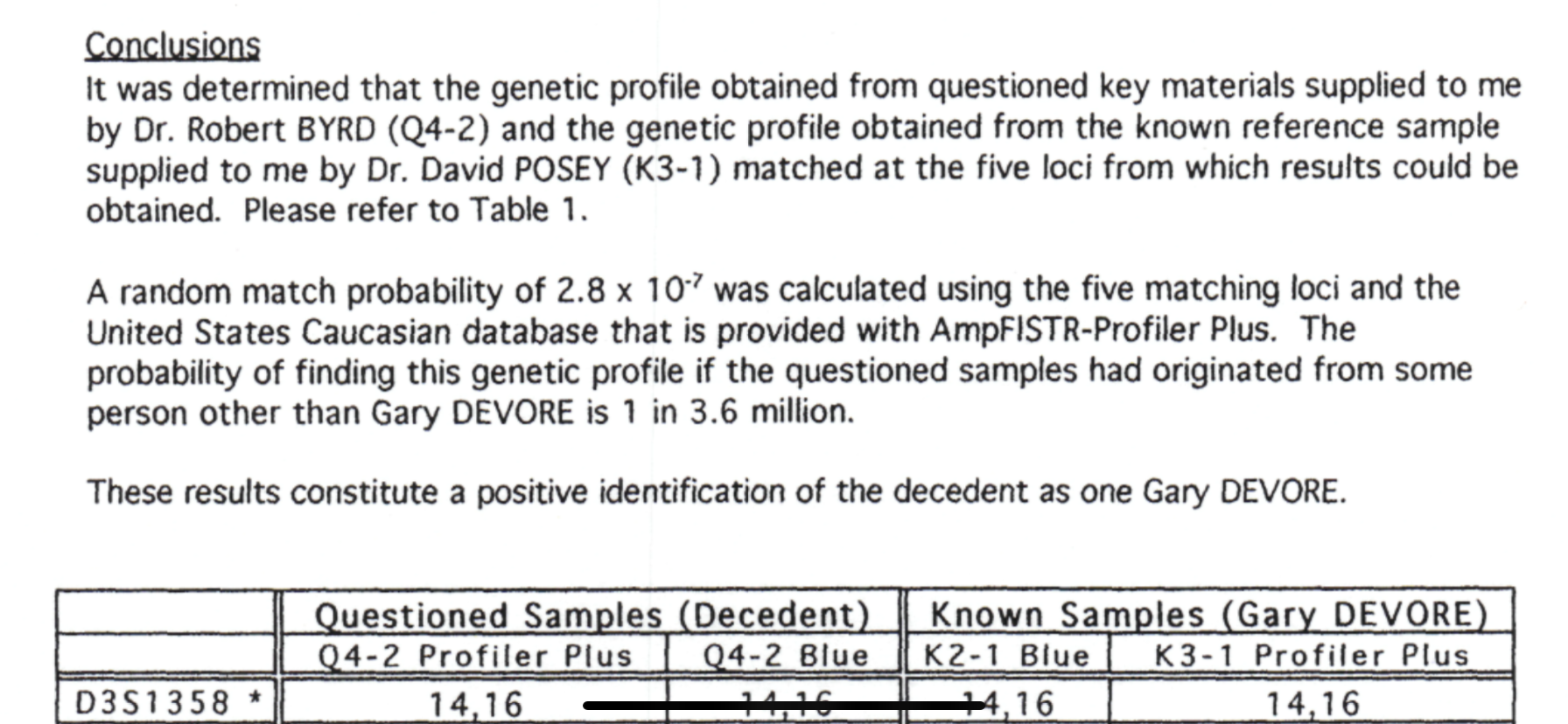
Gary’s family held a memorial at Hillside Memorial Park. After his remains were cremated, Devore’s family and friends still had questions and some suspected the remains were not his at all.
The FBI closed its kidnapping case, and the California Highway Patrol ruled the crash in the aqueduct as an unfortunate accident.
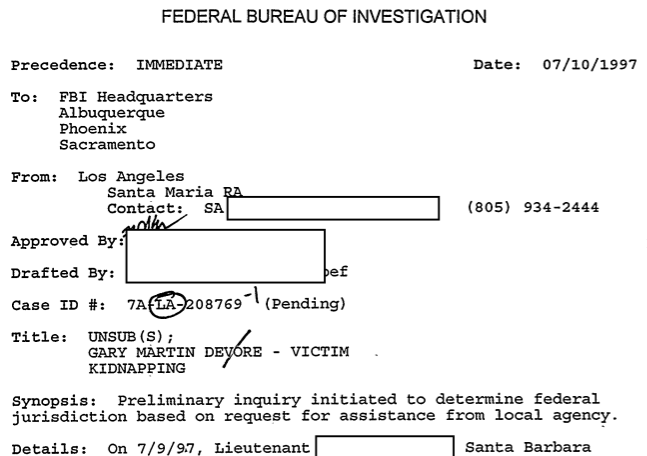
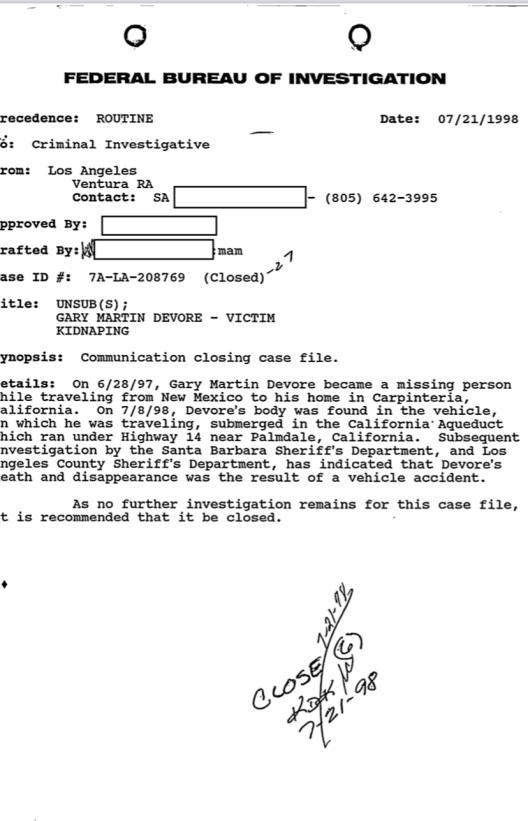
According to some of Devore’s inner circle, he did some work for the CIA, including photography, recruiting of assets, and Cyrillic translation.
During these travels, Devore may have become privy to sensitive material and used some of the information for his last screenplay “The Big Steal,” a tale about the U.S. invasion of Panama.
According to Devore’s close friends, ex-wives, and co-workers, he was an ambitious, driven and generous friend with a great sense of humor. He seemed to possess a strong sense of self, at times with conflicting character traits. He could be boisterous and volatile; his machismo and anger could sometimes get the better of him.
On one occasion, Devore was arrested by Beverly Hills police when he assaulted a driver who had cut him off at a traffic stop. According to friends, it was CIA operative Chase Brandon who got the charges dropped against Devore. Devore had met Chase Brandon in the 1980s and they became friends.
According to film director John Irvin, Devore had told him that he knew “disturbing details about the invasion of Panama,” and that “The Big Steal” would be “the hardest-hitting film studios have ever seen.” A first draft of “The Big Steal” included scenes of U.S. operatives robbing a Panamanian bank.
Allegedly, Chase Brandon was witnessed erasing the hard drive on Devore’s computer in the latter’s home days after Devore went missing. Chase has denied messing with Devore’s computer. He has publicly confirmed he was Devore’s friend but denied Devore’s involvement with intelligence work.
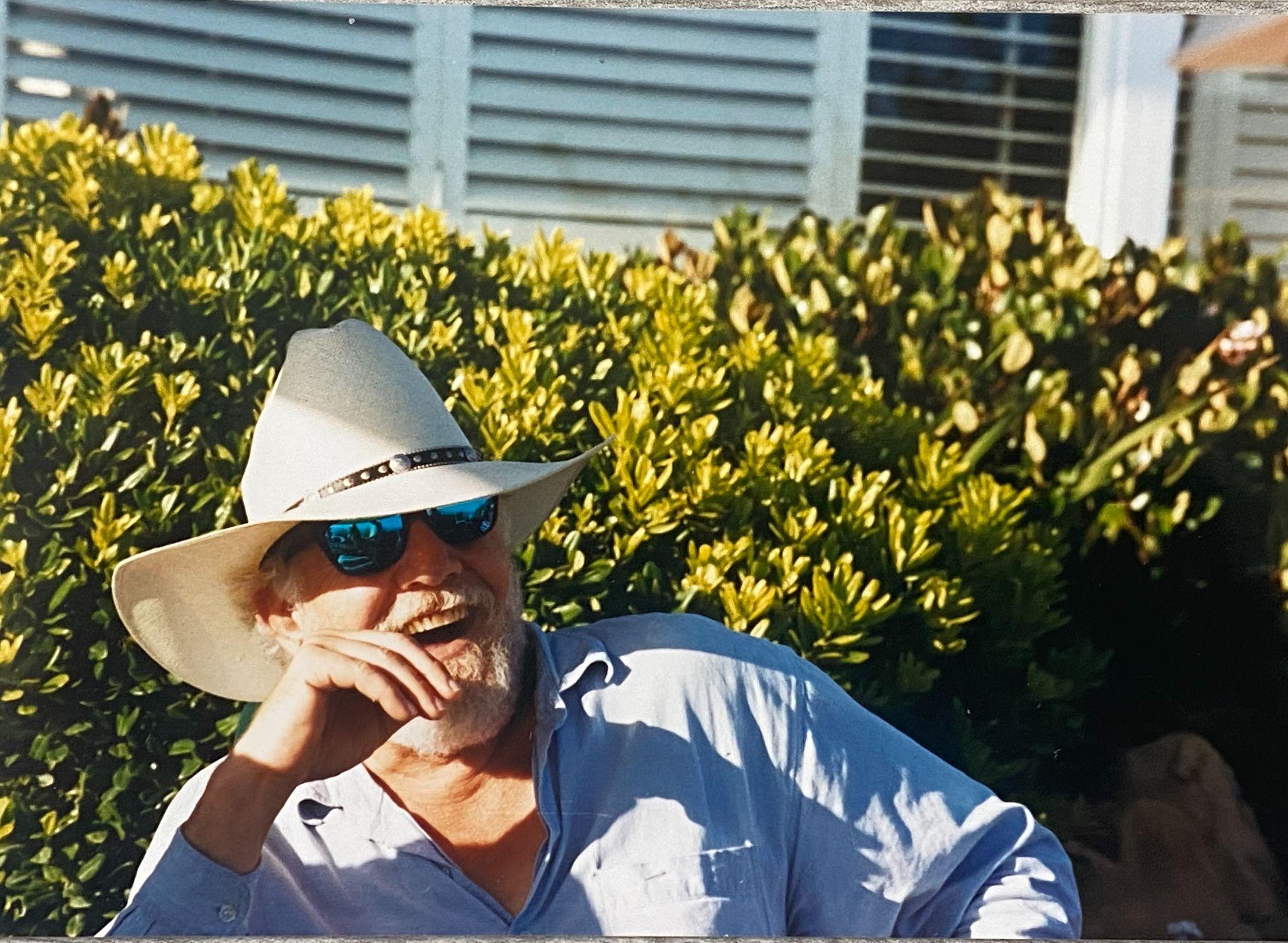
Chase Brandon was the CIA’s Hollywood liaison from 1996 to 2007; his job was to ensure “cleaner” portrayals of the CIA and U.S. foreign policy in Hollywood movies. When Brandon retired in 2007, Paul Barry took over his role at the entertainment liaison office. There was no proper passing of the baton; Brandon did not leave any records behind. The CIA claims it does not have any records on Gary Devore.
Attention for further investigation shifts back to the area where Devore went missing.
One thing is certain: The California Aqueduct that runs its waters through the valley is constantly monitored and maintained on land and from the air. How could Devore’s white vehicle gone unnoticed for more than a year?
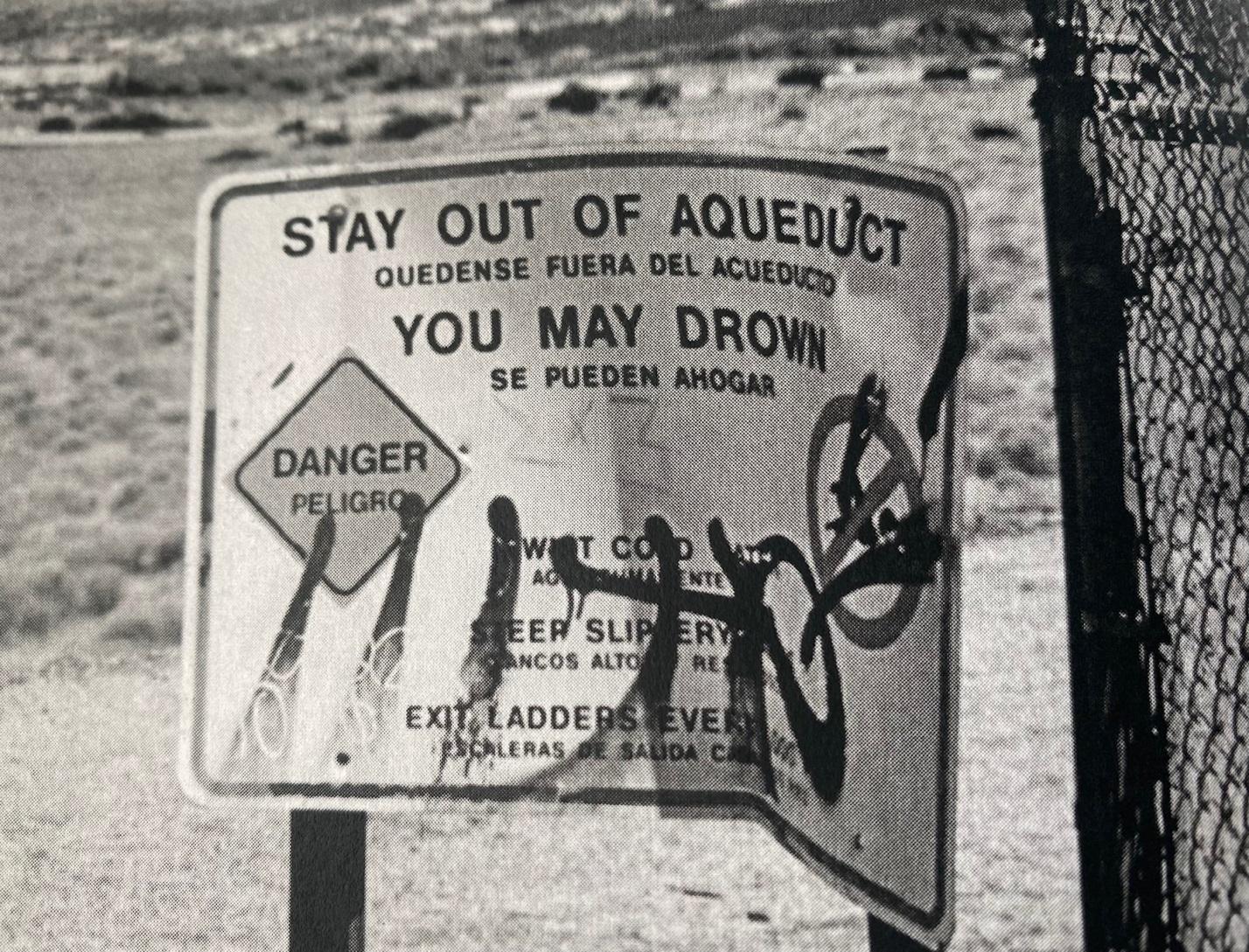
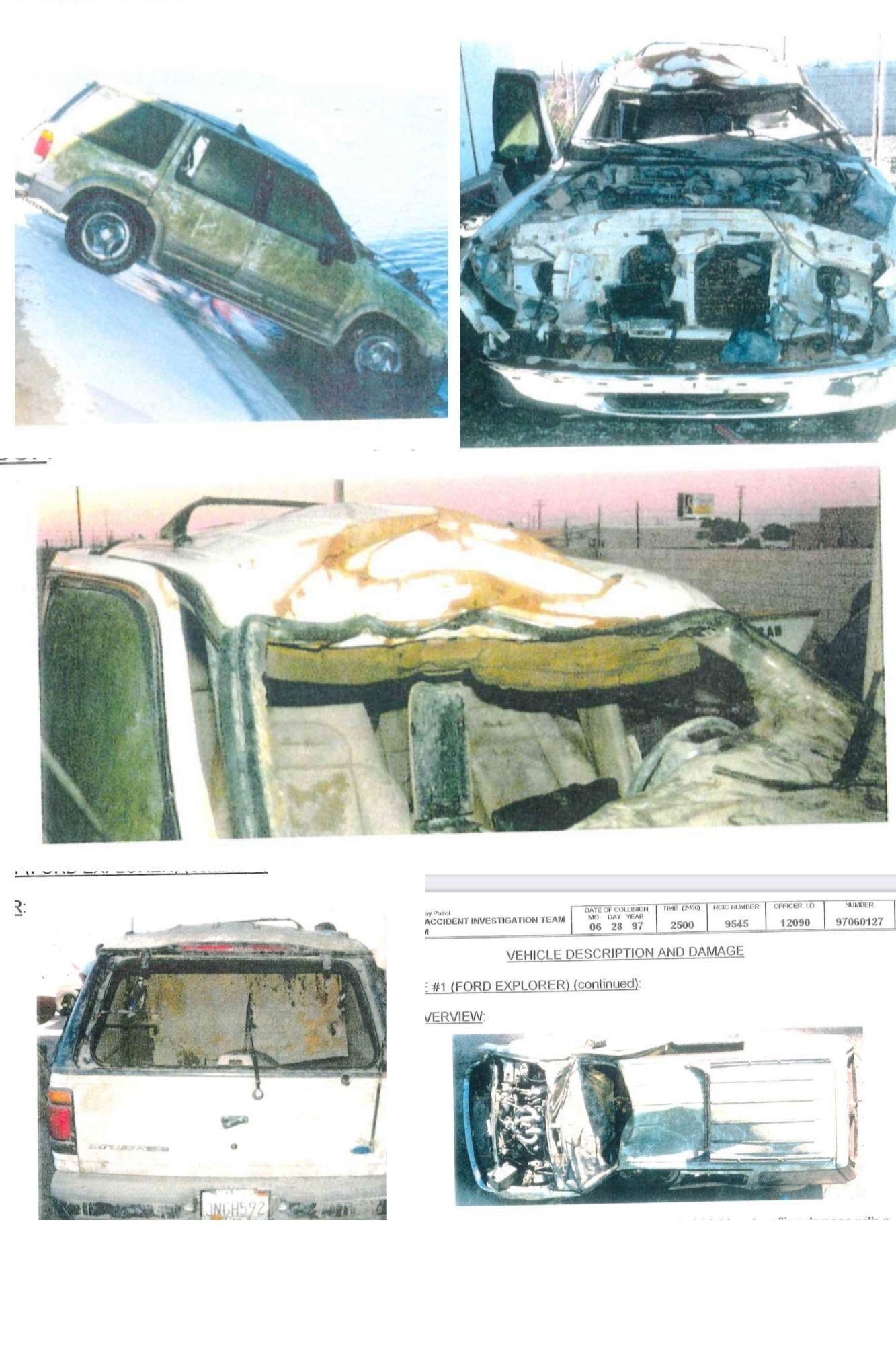
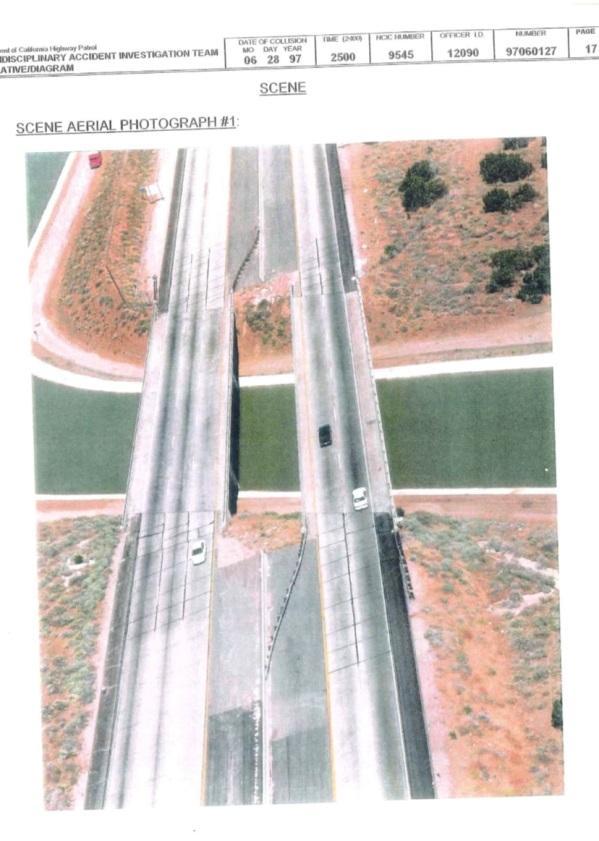
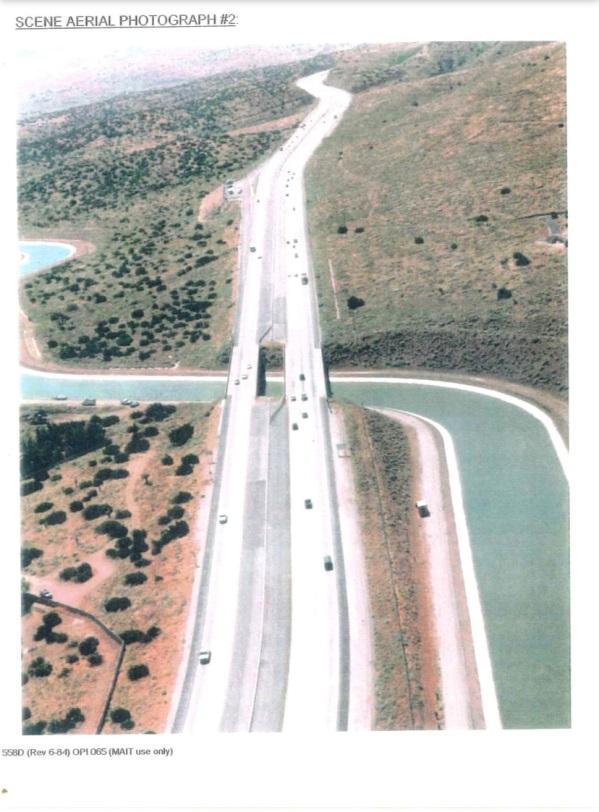
One lifelong resident of the Antelope Valley, who knows the area like the back of his hand, is “Jim Yellowstone,” an incarcerated individual who grew up in the Antelope Valley. His real name cannot be disclosed so as not to affect his pending case. He calls from a state prison to give insight into the infamous area.
“It would have been impossible for Devore’s car to have been in that water for over a year without having been spotted from above or from the ground.” He continues that he had a first-hand view of the aqueduct area and knows the inner workings of certain criminal organizations that operated in the Antelope Valley during the 1980s and 1990s. Up until his prison sentence Jim was involved in the distribution of methamphetamine himself.
“My grandparents used to own a tow yard there. I grew up there. I know that area like the back of my hand. If a vehicle was in the aqueduct, you could see that.”
According to Yellowstone, Devore’s accident sounds like a staged accident to cover up a crime. He does not believe that it was Devore driving that truck and accidentally crashing into the aqueduct. “The route he took from New Mexico to Santa Barbara… it seems way off to me, out of character. There were certain criminal networks, especially up north near southern Kern County, that were experts in getting rid of bodies. There was also a lot of federal activity. There was a lot of police presence in the entire area when they found Devore’s truck. That was because of that Sheriff’s Deputy who had disappeared. There was a big search out for him.”
Yellowstone refers to Sheriff’s Deputy Jonathan Aujay, who was last seen in Devil’s Punchbowl, a nature reserve area west of the aqueduct.
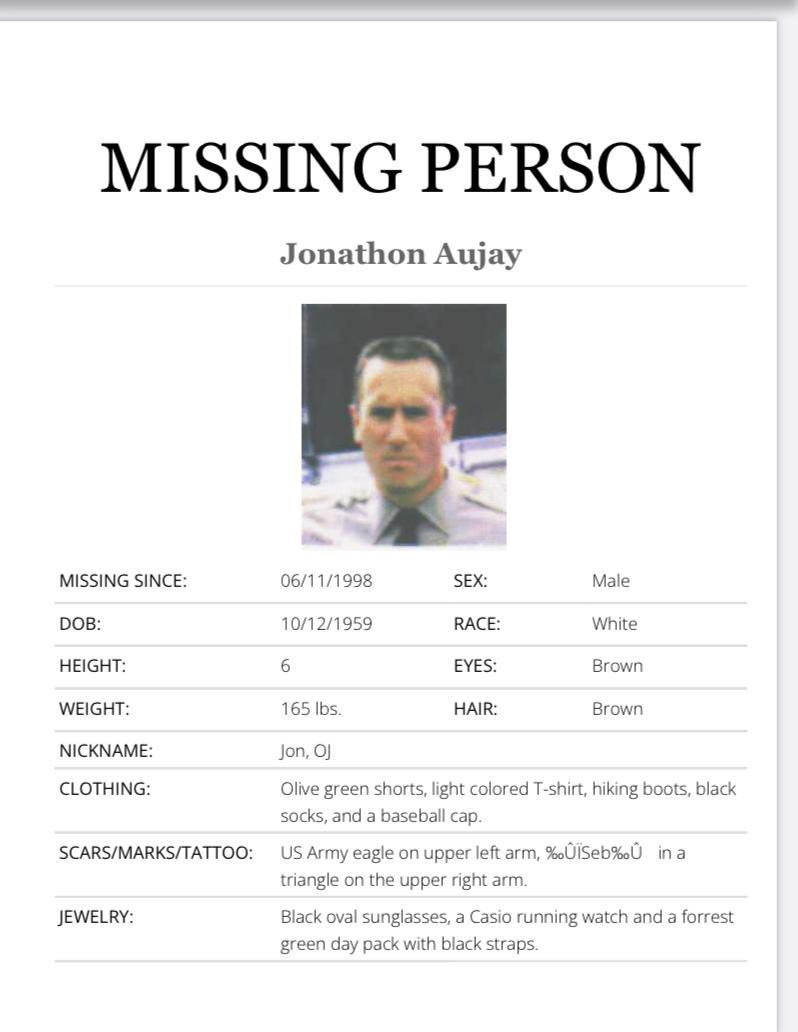
On June 11, 1998, six weeks before the recovery of Devore’s white Ford truck, Sheriff’s Deputy Jonathan Aujay disappeared in the nature reserve of Devil’s Punchbowl. His white Ford truck was found abandoned.[2]
Aujay was part of the Special Enforcement Bureau (SEB) for the LASD; he worked in the K-9 unit as a canine handler. Before this position, he was part of the hostage team as a sharpshooter.
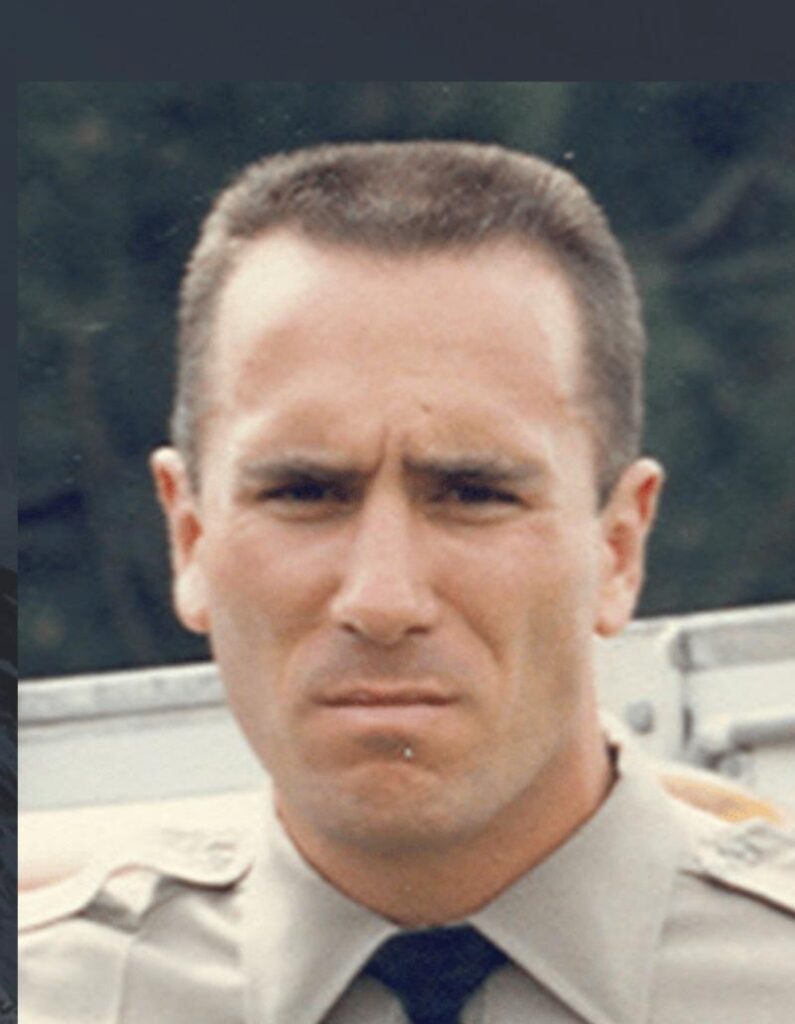
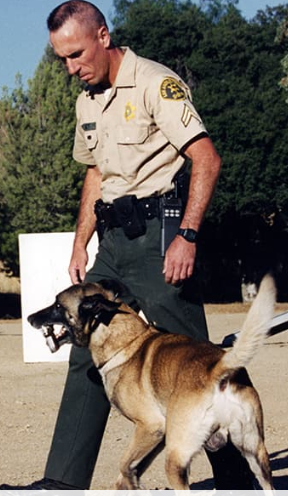
Aujay was a paratrooper for the Army Special Forces at the beginning of his career in law enforcement. He was sworn in as deputy for the SEB, where he transitioned to the K-9 unit as it seemed to fit him better than being a sharpshooter. It was said that he admitted to being troubled by having to kill someone during a hostage ordeal. He was more at home with dogs.
He had two distinct tattoos on either bicep: on his left arm bicep, an Army Eagle as an honor to his Special Forces work. On his right arm bicep, a “Yosemite Sam” tattoo with SEB written under it. The SEB houses LASD’s hostage negotiation, search warrant, SWAT and K-9 units.
On that June 11th morning, Aujay set out for a run from Devil’s Punchbowl to Mount Baden-Powell. He would be back by sunset, he told people in the park who witnessed him running. Another witness, a nearby resident, told park employees he had heard a single gunshot near Punchbowl.
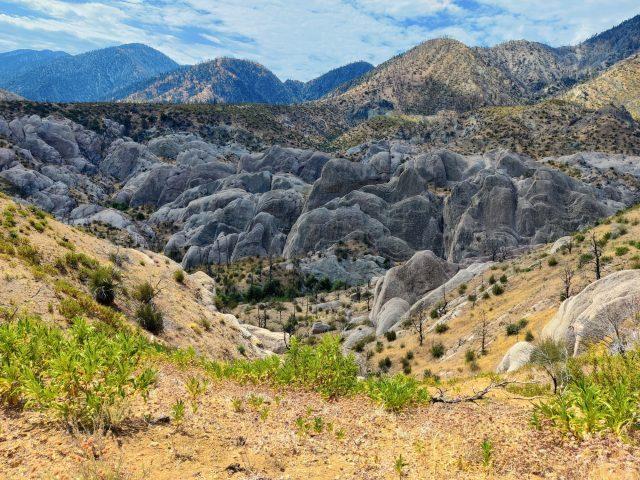
Aujay did not come home. His wife Debra reported him missing at the Palmdale Sheriff’s Office. Palmdale deputies spotted the white Ford and called for a search-and-rescue squad.
On the third day of the search, Saturday, June 13, 1998, search teams from Malibu and the nearby Edwards Air Force Base joined and deployed a Blackhawk helicopter; they used all-terrain vehicles, thermal imaging instruments, and infrared technology to search for any physical clues of Aujay.
After the multi-agency search for Aujay was called off, the LA Sheriff’s Department ruled Jonathan Aujay’s disappearance as a possible suicide.
This “possible suicide” ruling does not sit well with former Sheriff’s Captain John Michael Bauer.
Aujay was a physically fit ultra-marathon runner. Known for his integrity and candor, according to some of his fellow deputies and co-workers, he certainly had the grit to face any challenge.
The hallmark of extreme athletes is the ability to slash through walls of pain and exhibit remarkable mental endurance. Aujay’s strong will to persist, regardless of adversity, speaks volumes about his determination—whether or not this was due to a neurological advantage he possessed. It takes a complex interplay of neurotransmitters to combat the feeling of crashing.
Running alone is a race against oneself and the forces of nature. And Aujay was capable of carrying on with that race. For him, failure was never an option. It is possible that he occasionally turned to self-medication to manage pain, such as with ephedrine, a central nervous system stimulant, a popular substance.
Bauer has evidence that Aujay self-medicated. “In the 1996-1998 timeframe ephedrine was not yet a controlled substance, and drug producers like [Tom] Hinkle and others in his sphere, likely Del Roy High, had begun reducing (processing) ephedrine for use in making crystal meth. Their sources locally were cooperative small market owners and also foreign importation from Canada and presumably Mexico, of raw ephedrine. I have physical evidence that Aujay himself used ephedrine in his long-distance running activities and that tactical law enforcement [SEB officers] may also have needed to stay alert on long deployments, just like truck drivers. I have testimonial evidence that a co-worker at SEB provided this ephedrine to Aujay through the co-worker’s ownership (downline) of a pyramid business ordering “supplements” from China and elsewhere, and others at Aujay’s unit may have attained a downline business to order their supplements unsupervised.”
In a series of conversations, Mike Bauer discussed his lifelong mission to find out what happened to his Deputy Jonathan Aujay, who exactly was behind it and covered up the truth for so long.
Captain Mike moved away from Los Angeles after his tenure at the Sheriff’s Department, a force to which he was loyal for more than 30 years. He moved to Montana and bought a 182-acre hay farm. He cut and sold hay for about nine years. It was exhausting. Then something came along that set Bauer on a new path, perhaps a path that could lead to answers in cold cases.
“I was asked to become a Deputy Coroner for Sanders County. In my training for Coroner, at Helena, I was impressed with a suicide presentation that held that staged suicides are more common than people think, and to sign the Manner of Death on a death certificate we must ensure we have done everything possible to have certainty there is no foul play. This changed my orientation in my Aujay private investigation, to ensure a complete circumstantial investigation of the disappearance had been done, and quickly determined it had not. By interviews and research, and by investigation.”
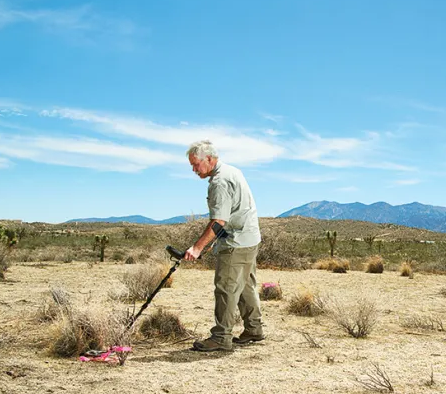
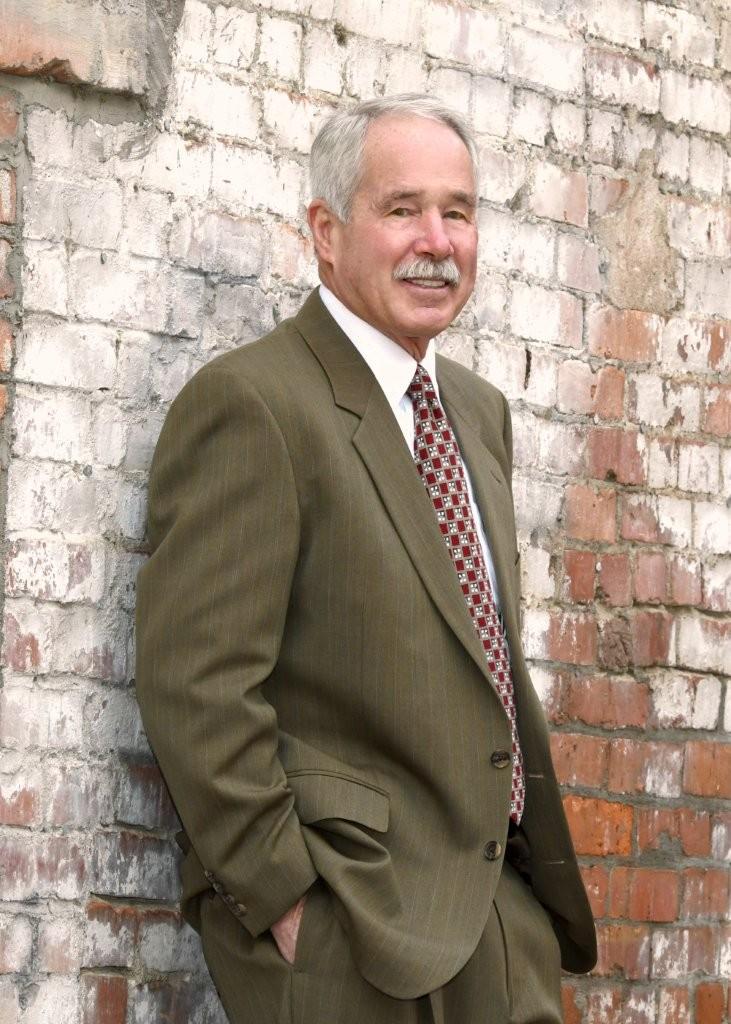
Bauer is a true detective by nature who started his days only to find some of the worst of human nature at the end of them. He has always given much of himself, committing his time to investigations and to eager podcasters, internet sleuths, journalists, and former fellow detectives who want to pick his brain for his experience and knowledge.
‘You’re asking me why I won’t give up? Here it is: The corruption of an agency I felt honored to work for is astounding. To this day the truth needs to be heard. I am adamant to find justice and to shine a light on the corruption within the department. I was sabotaged in my investigations multiple times. The department stopped me from accessing documents like disciplinaries of sheriffs and deputies.”
Bauer’s friend, Deputy Darren Hager, had received information from Homicide Detective Larry Brandenburg that “dirty deputies,” who protected criminals in the Antelope Valley, may have been involved in the murder of Jonathan Aujay. Hager reported this to his superiors but was fired not long after.
Looking at the area and criminal activities, Bauer considers a possible link between Devore’s demise and Aujay’s cold case plausible. He is concerned about the timing and locale. He shares his thoughts about Gary Devore’s demise in the Antelope Valley where the distribution of crystal meth is at the forefront of investigations, criminal activity, and corruption.
“Why would Devore have driven that route coming from New Mexico? If you needed crystal meth in the 1990s, Tom Hinkle was a manufacturer and distributor, and he lived very close by Route 138 that we will assume Devore drove toward Carpinteria.”
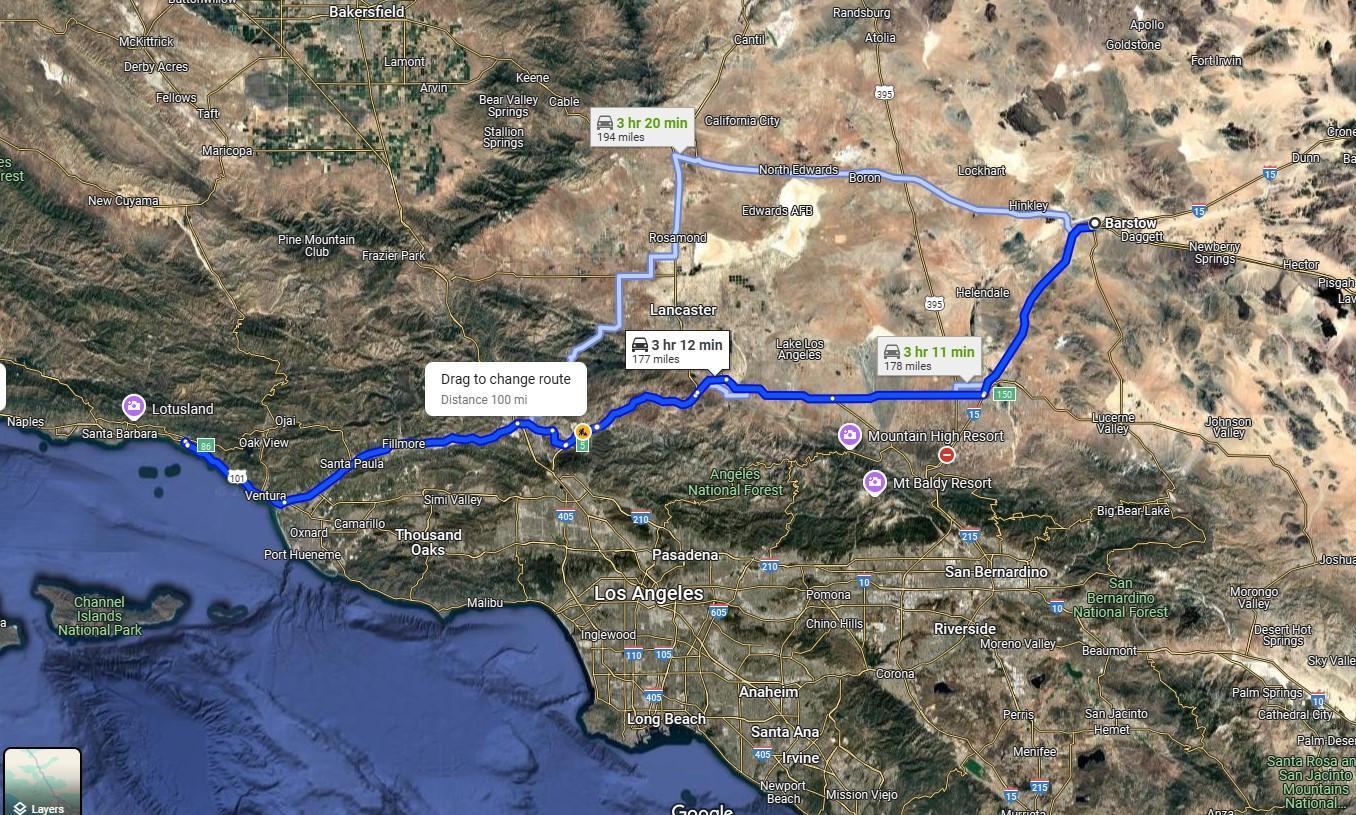
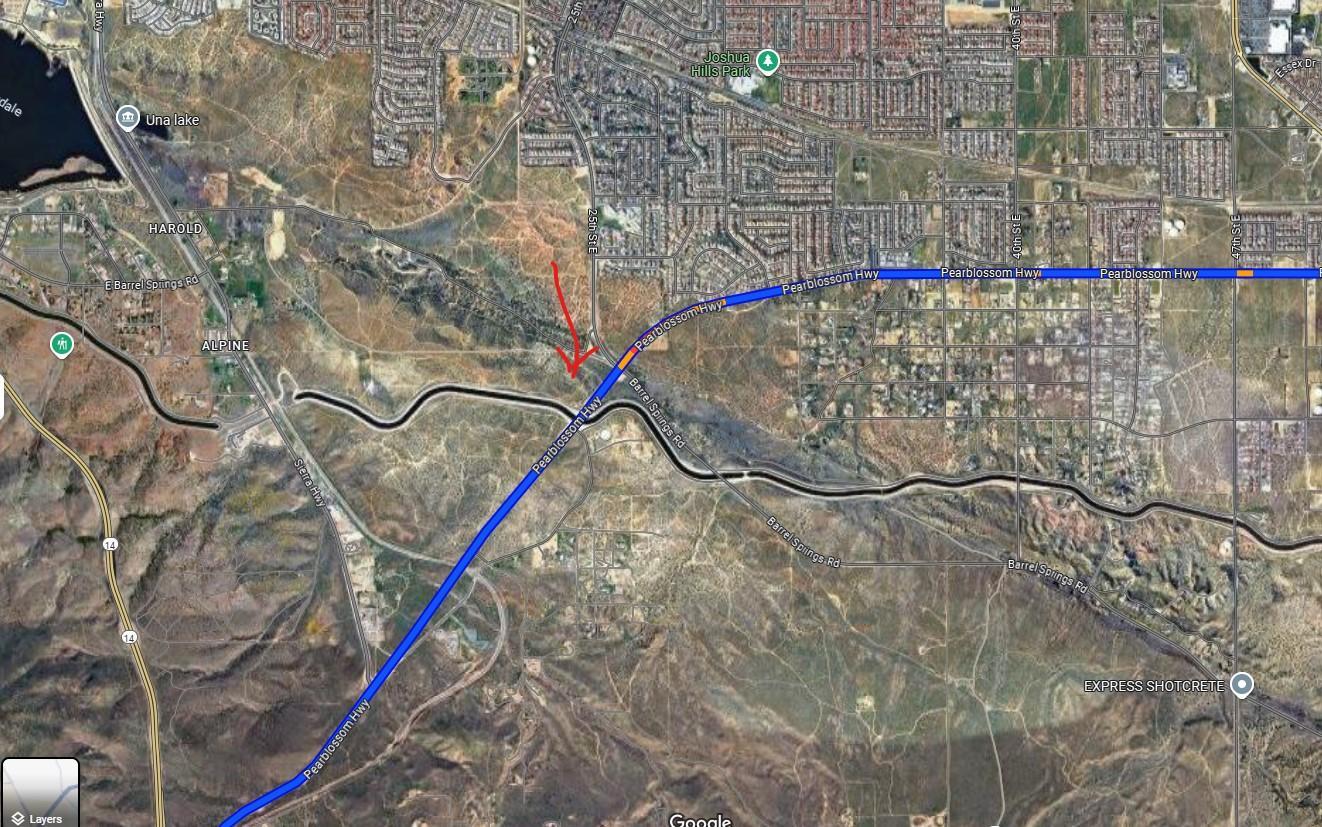
“Based on these maps, it seems a million to one that Gary fell asleep on 14 just exactly at the aqueduct crossing. It would be very sophisticated criminally to stage that location after his murder, and I assure you that the Hinkle world has demonstrated many times that disappearance has been developed at an advanced level, and that absent a body the entire matter is easily resolved as just a disappearance. We have seen this many times with this drug ring. They are very experienced disposers of dead bodies.”
Bauer’s attention goes to the tow yards: “The California Highway Patrol frequently used the local tow yards during recovery. Some of these tow yards were also under investigation for drug distribution. In that particular era, the CHP had ‘problem employees,’ issues with meth.”
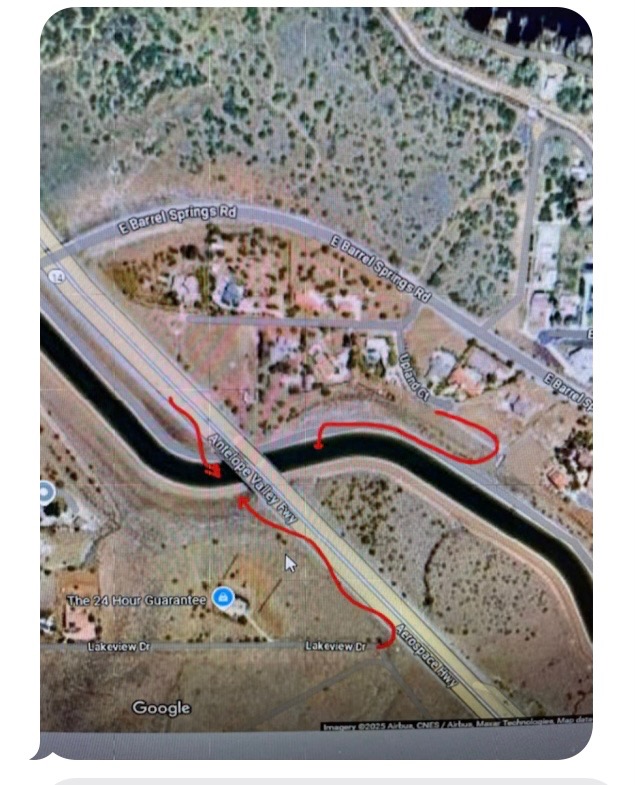
He mentions Clark and Howard Towing, a tow yard very close to the aqueduct crossing, near Barrel Springs Road. Clark and Howard Towing was often used by the California Highway Patrol. And in the case of Devore, Clark and Howard Towing was first used before the truck and skeleton were transported to Antelope Tow Yard.
Looking for clandestine graves
The Antelope Valley is a 3,000-square-mile high desert basin in California that spans both northern Los Angeles County and southern Kern County. The valley is located in the western Mojave high desert and is bordered by the Tehachapi Mountains in the north, the Sierra Pelona Mountains on the west side, the San Gabriel Mountains in the south, and Victor Valley and the Great Basin border the valley on the east side.
The valley’s geologic formations consist of consolidated rocks that are mostly non-water-bearing, and water-bearing deposits that are mostly unconsolidated. It can have reddish Navajo sandstone rocks, rugged terrain, caves in the rock formations as well as more sandy clay (alluvium) and solid clay deposits. Despite some more challenging geological areas, it would still be possible to find human remains, even in cold cases, especially with high-tech geomatic instruments like laser scanners, multi-spectral cameras mounted on drones, and even with the more traditional geophysical tools like ground-penetrating radar tools (GPR). It is more difficult to search for graves with drones at higher elevations in the mountain ranges where the wind speeds are problematic and in caves where the light is an issue.
Bauer was told by informants that people were sometimes dumped in endless barrels in the water so that they could never be found. Even with highly experienced divers and underwater cameras, it would be impossible. GPR, when used over water can detect what is underneath the water, while the equipment itself sits on top of the water.
The method of setting trucks ablaze with high-accelerant chemicals was often another method to get rid of human remains and DNA traces.
To find missing persons or clandestine graves, police can ask for help from a geographic profiler or crime analyst. Grave detection would be an additional expertise of forensic anthropologists or geophysicists.
Originally from Canada, Dr. Victoria Berezowski, a forensic scientist, assists law enforcement in finding clandestine graves. She traveled to Australia for her Ph.D. which focused on grave-location techniques. She proved her techniques could find graves. Dr. Berezowski is now a lecturer of forensic science at Deakin University in Victoria, Australia.
Dr. Berezowski specializes in covert/illegal burial detection using a multidisciplinary technique that involves geographic profiling, laser scanning, and near-surface geophysical techniques, such as ground penetrating radar (GPR) and electrical resistivity tomography (ERT) which transmits energy waves into the ground to create images of the sub-surface. She uses these techniques to assist law enforcement in homicide cases where the victim has been disposed of in a clandestine grave.
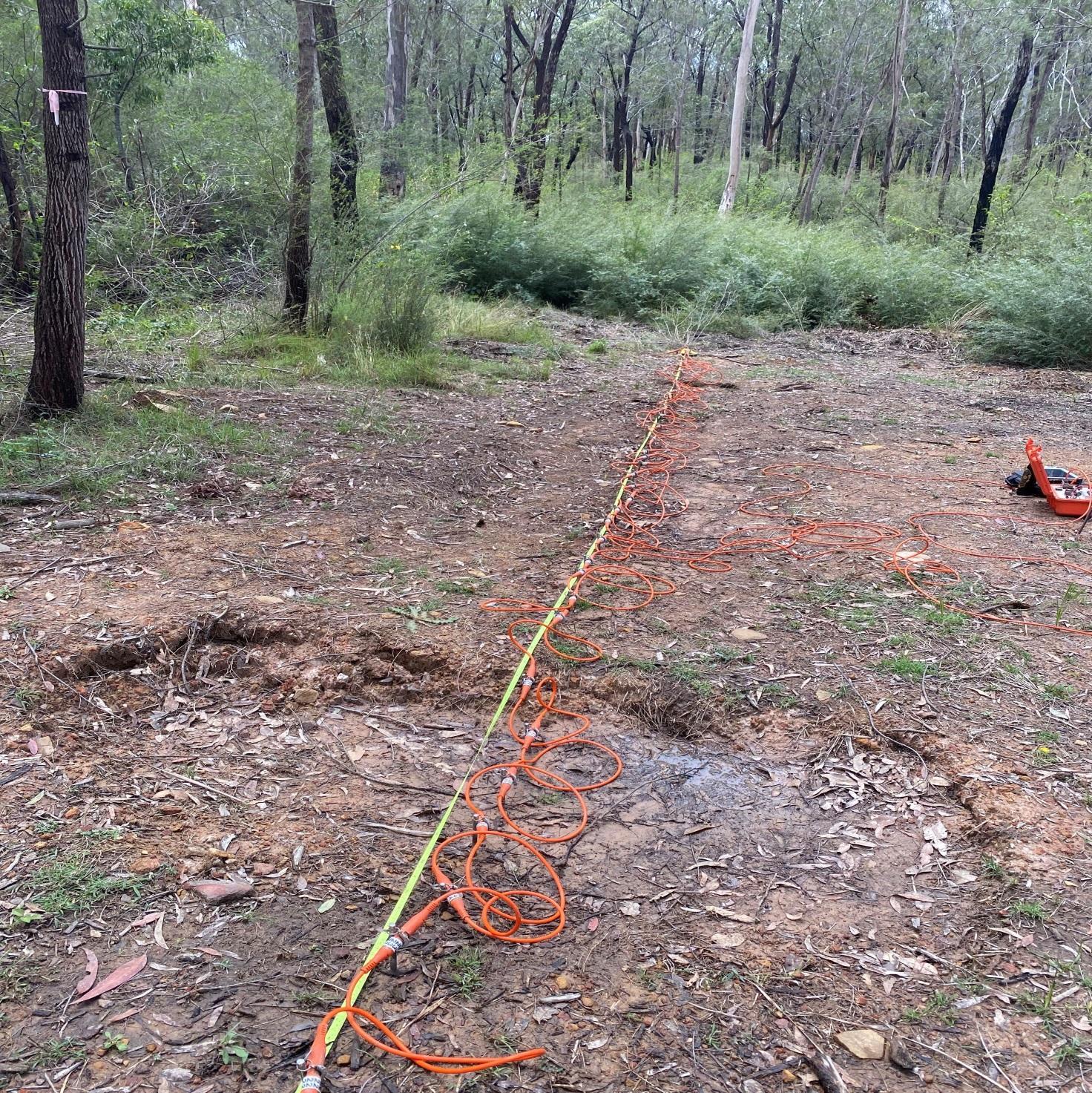
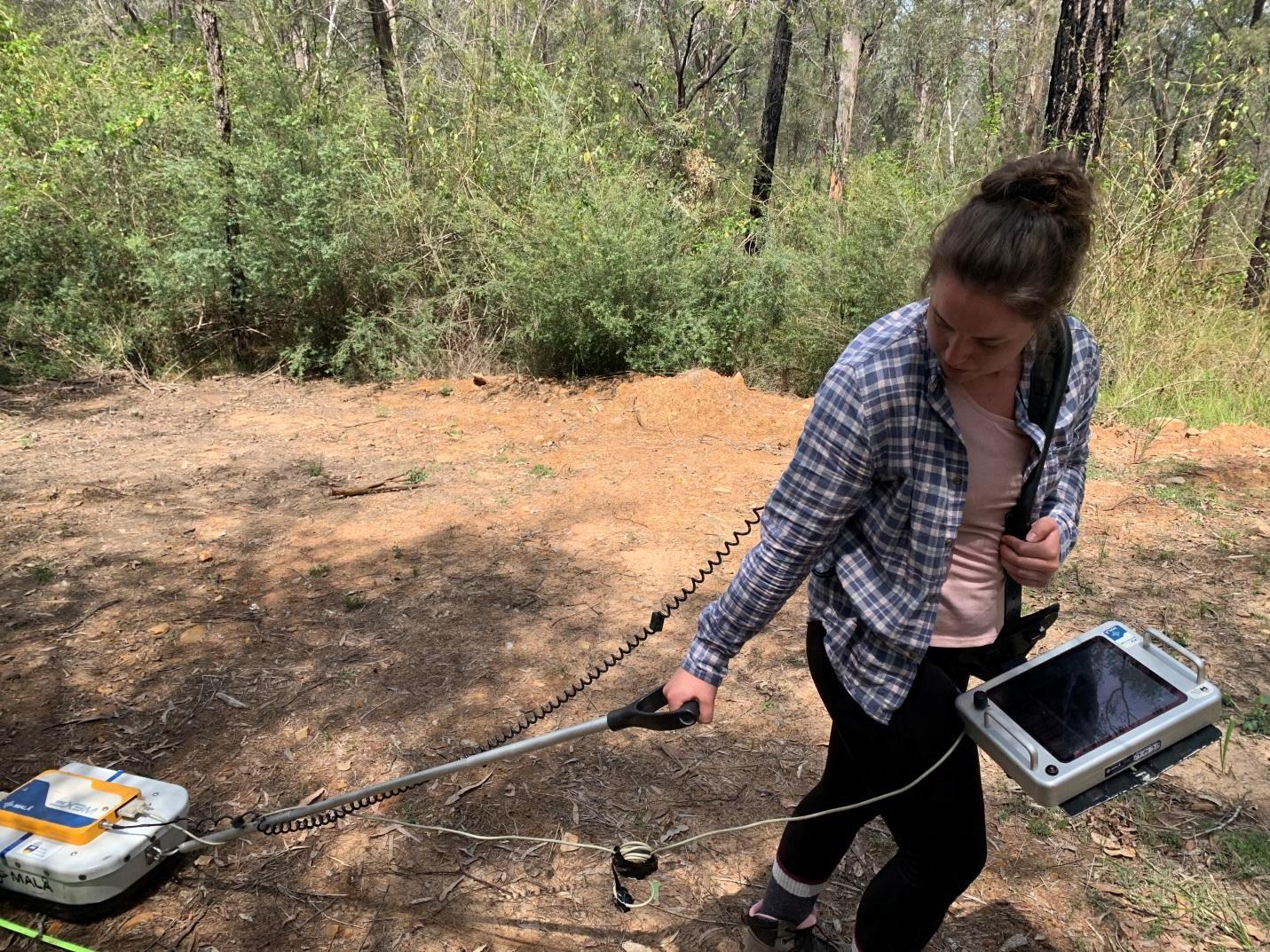
Berezowski:“The search environment can have been changed over the years through human-made and natural environmental changes – through the addition of soil, rocks and elevation changes. The slow small changes can be harder to detect, but easier to deal with in finding a grave. Drones with LiDAR (Light Detection and Ranging) attached, and multispectral cameras can detect subtle changes in the ground like elevation changes. Aerial photographs can also detect these changes.”
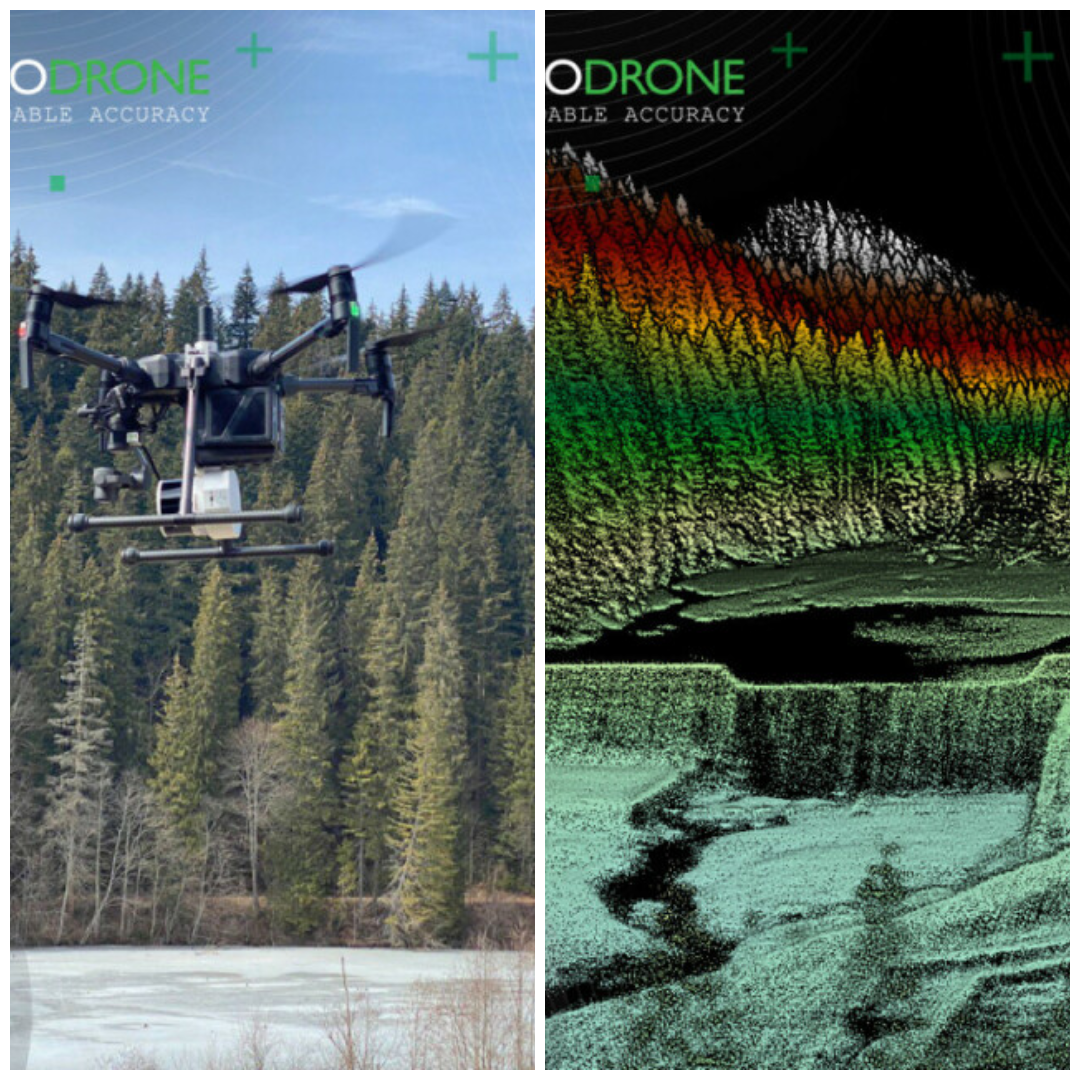
Aerial photography has been used for decades in geology and forensic science. The technology has progressed with high-tech applications like drones, multi-spectral cameras, and thermal photography.
“LiDAR, a laser scanner attached to a drone, is wonderful because it penetrates through dense areas like tree canopies and captures the ground surface. When we process the data, we can peel back those layers to the ground.”
Although ground penetrating radars (GPR) can be useful, GPR is still very soil-dependent. “GPR doesn’t work well on clay, because clay is a very compact material. The GPR sends out a signal but loses energy when the signal goes back up to get data. The depth is reduced. GPR does work well on sandy clay.
Overall, it’s very rare that GPR detects skeletal remains. “It does detect disturbances in the soil.GPR can detect the difference between disturbed and undisturbed areas. But the problem is GPR detects any disturbance. Any sort of change, GPR is going to detect anomalies.”
In some conditions, it would be more difficult to use drones with lasers such as on mountains where the wind speeds are higher. “The wind speeds and strength are much higher in mountainous areas. Drones, depending on how heavy they are, don’t work well in the wind. And looking for graves in caves would also be hard because you have to keep the drone in the cave, you can’t let it fly high. And light is an issue there.”
The Devil’s Punchbowl, where Jonathan Aujay disappeared, is a dramatic gorge within the Devil’s Punchbowl Natural Area, an L.A. County park that lies within the expansive Angeles National Forest, north of the majestic peaks of the San Gabriel Mountains.
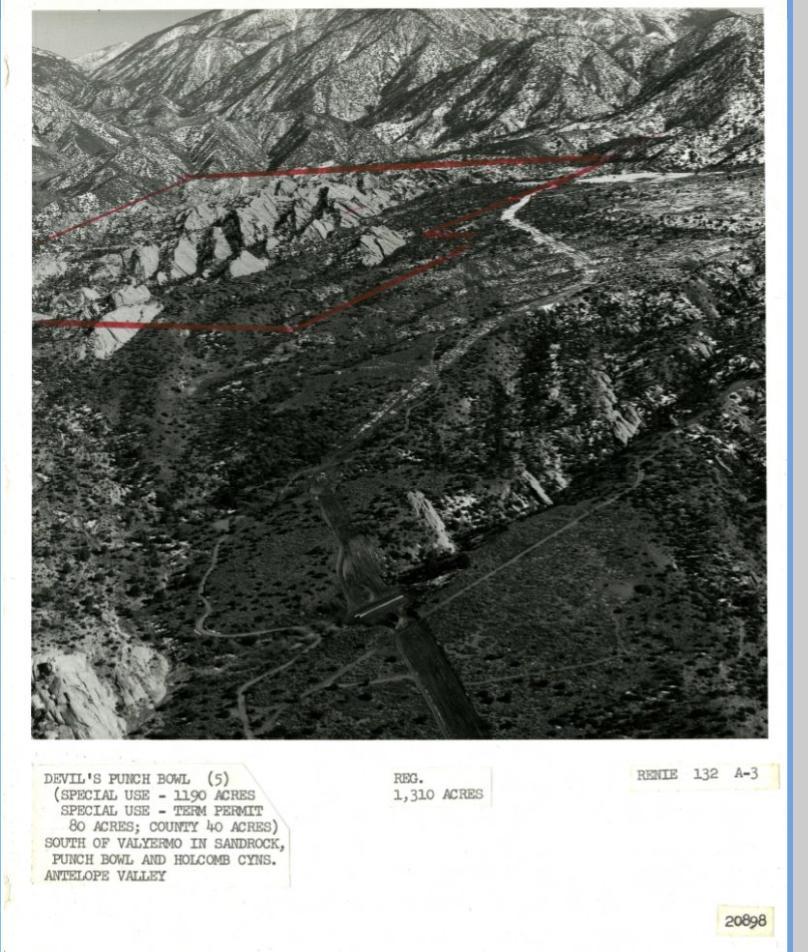
This region features layers of sedimentary sandstone that have been tilted to nearly vertical angles by the nearby Punchbowl and Pinyon Faults, which are offshoots of the San Andreas Fault. The surrounding terrain has eroded, exposing this unique and twisted geology.
From an aerial perspective, the entire Devil’s Punchbowl Natural Area borders a property on the east side that was supposedly an underground methamphetamine lab.
The Antelope Valley is characterized by a variety of vegetation, varying elevations, sandy red rock formations, and diverse clay soil. Laser scanners mounted on drones could prove useful in new searches for graves, along with electrical resistivity tomography, which can create images of elevation changes.
Crime mapping
When does a perpetrator commit a crime in the same area? Why a specific location and how?
These are some of the questions in geophysical profiling that can aid detectives in finding criminals and their victims.
In the world of crime investigations geophysical profiling or “crime mapping” is the study of criminal “spatial” behavior. It studies the crime pattern, the logical choice, and the routine activity.
According to Dr. Berezowski, crime-pattern theory posits that the chosen environment is ideal for the perpetrator based on the physical, spatial, cultural, legal and psychological characteristics resulting in a method of operation (MO).
By mapping out all information on possible activity, timing, buildings, last-seen locations and, in cold cases, old buildings and demolished/closed sites, geographic profiling can generate leads.
According to Canter’s Circle theory, developed by psychologist David Canter, an offender’s home base would be situated centrally in the geographical area where they commit a crime, forming a circle around their “residence.”
Canter’s circle theory suggests there are two types of offenders: marauders and commuters. Marauders are people who hunt away from their anchor, but stay close to their habitat. Commuters are criminals who travel further away from their activity space. They create a buffer zone around their habitat to avoid detection.
There is a third type of offender: a troller. This type is a combination of a traveler and a marauder.
Examining the behavior of potential criminals can reveal their psychological needs and motives. One of our fundamental human needs is safety; we all desire to feel secure. Criminals often establish routines that provide them with a sense of safety, which allows them to commit crimes. This feeling of safety largely stems from the reassurance that they have evaded detection.
The criminal network of Tom Hinkle in the Antelope Valley is suggested to have enjoyed local police protection for a long time.
Tom Hinkle was a key figure in crystal meth production in the Antelope Valley. He worked for a few years at the Bermite Powder Co. in Newhall, which made military explosives and related equipment. It could be speculated that, during that particular time, he amassed important federal and local police connections, by way of money and/or compromise. During an incident at his house with a pipe bomb, a woman was killed. Hinkle was never suspected of any foul play; instead, someone else went to prison.
The Hinkle network operated during a time of “heavy” police scrutiny under Sheriff Sherman Block, who initiated “Big Spender,” an internal affairs program of the Los Angeles County Sheriff’s Department, to root out police corruption. Yet, the Hinkle organization got away during high-level police scrutiny. At that time, Frank Merriman spearheaded the Homicide Division of LASD. Criminals like Hinkle often use a method to assert power: placing deputies in compromising situations like extramarital sexual behavior or drug offenses.
According to Bauer, “I think the protection Hinkle got derived not from the Feds, but from Homicide Bureau Frank Merriman, who was compromised by Hinkle in 1994 when he allowed Hinkle to get away with murder to frame someone else. This was a powerful motivation to take down Deputy Darren Hager and the DEA Silent Thunder taskforce.”
Darren Hager himself received information about another deputy, Richard Engels, who may have protected the Hinkle organization and was likely involved in the murder of Jonathan Aujay. In a court transcript of a different appeal in 2021, Hager states that Engels threatened to kill him.
In Bauer’s ongoing investigations into cold murder cases, Deputy Engels is one of the few but likely suspects.
“He is a grandstanding, tobacco-chewing guy. I should have known early on that he was unsound, corruptible. He is a bear hunter and collects mules. These are pricey and at that time it was quite something to buy expensive mules on a deputy’s salary. So where did he get the money from? Perhaps an inheritance as such, but it makes one think about extracurricular, shady activity.”
Deputy Richard Augustus Engels attended Pierce College (now Los Angeles Pierce College) majoring in Animal Husbandry. At Pierce, he was close friends with Lee Eugene Vorhies and his wife Kristen. Those two married at 19 and divorced after the birth of their daughter Jennifer. Jennifer and her father Lee visited often with friend Rick Engels in Juniper Hills, California, where Engels and his wife Lyn bought and sold expensive show horses and show mules, and Rick also engaged in bear-hunt guiding with the assistance of Lee Vorhies.
Deputy Engels’ suspected shady activities seem numerous, ongoing, and unstopped.
During the 1990s he was at one time suspected of “having received automatic weapons from whoever broke into the Palmdale Reserve Arsenal because he was caught by witnesses firing fully automatic weapons in that region, for which he had no reason to possess,” says Bauer.
On the afternoon of September 23, 2006, Rick Engels called 911 to report a double suicide in his home, Lee Vorhies, age 47, and his daughter Jennifer Storaasli, age 27. The instrument was a handgun belonging to Rick Engels; Engels explained that Jennifer shot herself.
She was shot in the back of the head. It was rumored that Engels had an inappropriate relationship with Jennifer, which leads to speculation as to who is the father of her kid.
“The LASD closed the scene as a tragic double suicide and stonewalled the local newspaper, which eventually forced a press release on the matter. I have conducted extensive interviews on this event with members of both families and the resolution of the matter is unclear. I detect foul play in several areas.”
Tom Hinkle’s criminal headquarters was close to a point on Highway 14 where Gary Devore vanished. Bauer stresses the importance of that location. “The area where Gary Devore disappeared was at that time very dangerous, especially on Highways 138 and 14. You could get shot just by stepping out of your car, especially at night.”
Although some dispute the coroner’s report of Gary Devore, Bauer, himself a former deputy coroner, is 90% certain that the handless skeleton found in Devore’s truck was Gary Devore.
“Because of the DNA matches in the coroner’s report of Dr. Posey, Dr. Sweet, and Dr. Byrd. All his organs were removed, which suggests the body was kept somewhere else for a long time. To avoid detection during the decomposition, his organs must have been removed. It is possible he was kidnapped and murdered elsewhere. They must have hidden the truck and body for a while.”
In their search for Gary Devore, the FBI overlooked the significance of finding a burned-out car during their investigation into the missing Devore.
Besides disposing of bodies in wells and freezers, under concrete-filled cavities, using high-accelerant chemicals to burn away DNA traces appears to be another routine tactic employed by the named criminal networks in the Antelope Valley.
So far two things stand out: repeated crimes in the same area with similar methods and alleged police protection. One could say that these criminal networks became experts in the disposal of bodies because they were protected. It was safe to repeat the crime.
Antelope Valley and Los Angeles in a problem era: crack cocaine, crystal meth, and corruption
A third case that still raises questions is the death of journalist Gary Webb. After obtaining a grand jury indictment, Webb investigated the theory that certain intelligence officers collaborated with drug dealers to facilitate the distribution of cocaine in the United States. A former DEA agent, Celerino Castillo, provided evidence indicating that both the CIA and DEA were aware of drug distribution efforts to fund the Contra War in Nicaragua.
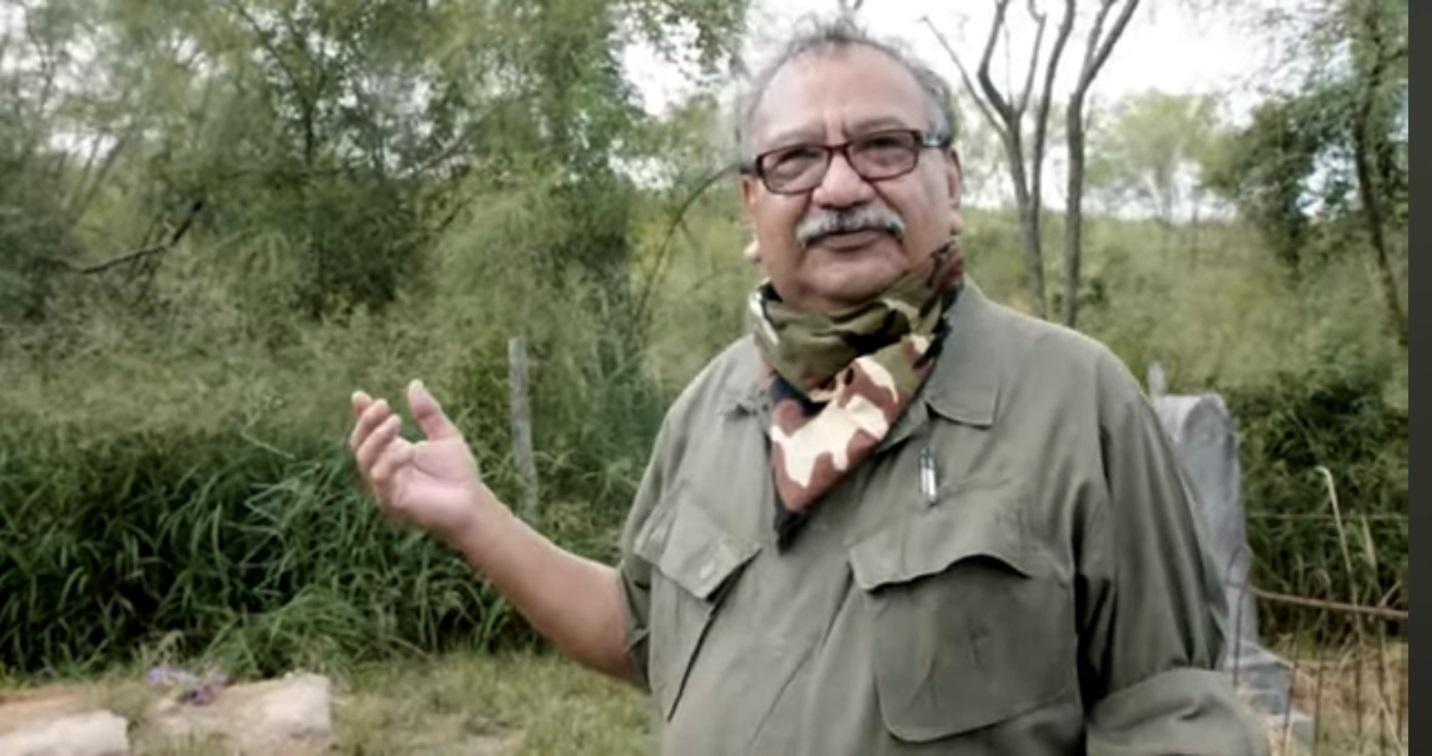
In the summer of 1996, Webb published a three-part article titled “Dark Alliance.” Webb’s investigative series on contra-cocaine-CIA connections prompted internal investigations by the CIA and the Justice Department. These probes confirmed that numerous Contra units and individuals connected to the Contras were implicated in the drug trade.

Based at the San Jose Mercury News‘s Sacramento bureau, Gary Webb linked the CIA to the Nicaraguan Contras, who aimed to overthrow the Sandinista government, and to the sales of crack cocaine that flooded south-central Los Angeles in the 1980s.
Even after U.S. Justice Department Inspector General Michael R. Bromwich issued findings in 1998, major newspapers failed to communicate these significant government admissions to the American public.
Webb’s article faced substantial criticism, particularly because of a perceived lack of on-the-record sources. Both the CIA and major newspaper organizations worked to undermine Webb’s credibility.
He lost his job and family. On December 10, 2004, Gary Webb was found dead, at age 49, with two gunshot wounds to the head in Carmichael, Sacramento County, California.
His death was ruled a suicide. Sacramento Coroner Robert Lyons said at the time that his office had been swamped with calls. “It’s unusual in a suicide case to have two shots,” he said, “but it has been done in the past, and it is a distinct possibility.”
Before Gary Webb’s exposé, however, the DEA ran a covert operation out of the Antelope Valley, specifically in the desert terrain between Littlerock and Pearblossom. They infiltrated small-time drug dealers—some of them owned tow yards—and attempted to recruit ring leaders of criminal organizations. The covert operation included the manufacturing of methamphetamine laced with MDMA as a distribution tracer.
Jim Yellowstone claims that, in the winter of 1991-1992, he was approached by the DEA: “I was introduced to a ‘special agent’ named Charles Robinson. He asked me to stop my distribution of meth. I was taken to a manufacturing facility out in the desert between Littlerock and Pearblossom. The lab consisted of trailers surrounded by security fences. They showed me around, pressed me to cooperate.”
But Yellowstone refused to cooperate and the DEA threatened to have him arrested. Yellowstone took off for a while. When he returned to his home base, he went to check out the area. The DEA lab was gone and the ground had been scraped clean.
During their covert operations, the DEA asked local police, including the LASD, for assistance. But, according to Bauer, “That didn’t mean local deputies knew what was going on or what the assistance exactly was for. They were not informed about what the DEA was doing.”
In 1982 the DEA established the Organized Crime Drug Enforcement Task Forces (OCDETF) program. It was set up to curb and erase the illegal drug trade in the U.S. and all criminal activity associated with it, like illegal weapons and human smuggling and trafficking, including kidnapping and murder.
The DEA listed on its website, the OCDETF’s mission statement: “OCDETF employs a national strategy of coordinating multi-agency, prosecutor-led law enforcement operations, driven by intelligence and supported by OCDETF funding. OCDETF uses this strategy to target the supply, transportation, leadership, and financial networks of drug trafficking and money laundering organizations.”
The DEA’s mission and OCDETF’s main priorities are similar: “Target, disrupt and dismantle drug trafficking and money laundering organizations, reduce the illegal drug supply in the United States, seize assets, and bring criminals to justice.”
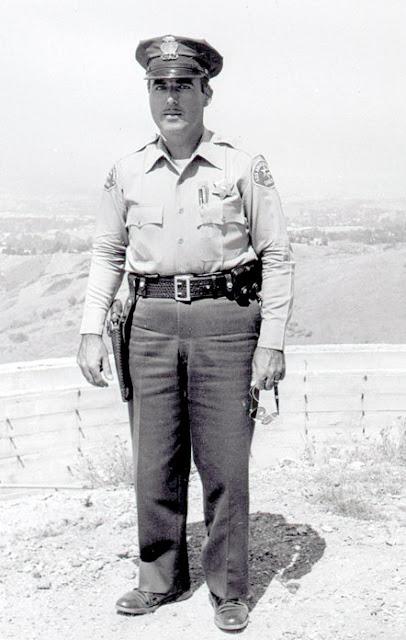
Simultaneously, the LASD under the leadership of Sheriff Block instigated the “Big Spender” task force out of the Detective Division HQ to detect and eradicate wrongdoing and corruption at the Narcotics Bureau. Larry Waldie was the Captain of Narcotics at that time. Big Spender operated under the auspices of a federal grand jury and included the United States Attorney and investigators from the Sheriff’s Department, the FBI and IRS.
In its Year in Review 1992, Sheriff Block referenced indictments of 21 LASD deputies and low-ranking officers on various charges that included theft, conspiracy, money laundering, structuring, tax evasion, obstruction of justice, perjury, and conspiracy to sell illegal drugs. Federal juries convicted 14 deputies while seven others were awaiting trial. The report stated: “It should be noted [these] statistics represent a very small percentage of our Narcotics Bureau personnel and should not reflect on the honest, hard-working majority of Narcotics deputies who day in and day out do an excellent job.”
Larry Waldie had moved on from the Narcotics Bureau of LASD and became Assistant Sheriff before Aujay’s disappearance in 1998.
After Sheriff Block passed away in 1998, Leroy D. Baca became Sheriff of Los Angeles County until 2014. Baca was convicted of obstruction of justice in 2017 and was sentenced to three years in federal prison for his role in a scheme to obstruct an FBI investigation of abuses in county jails. He reported to prison to begin his sentence on February 5, 2020 and was released in January 2022. He now lives with dementia and wears a medical bracelet. Baca was reported missing on a Sunday night in July 2024. Authorities found him alive and well in the early hours of following day.
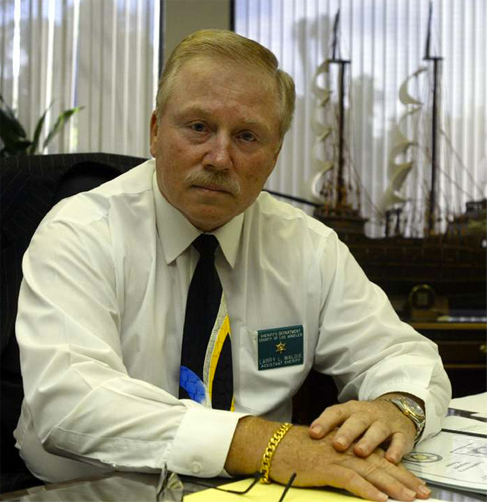
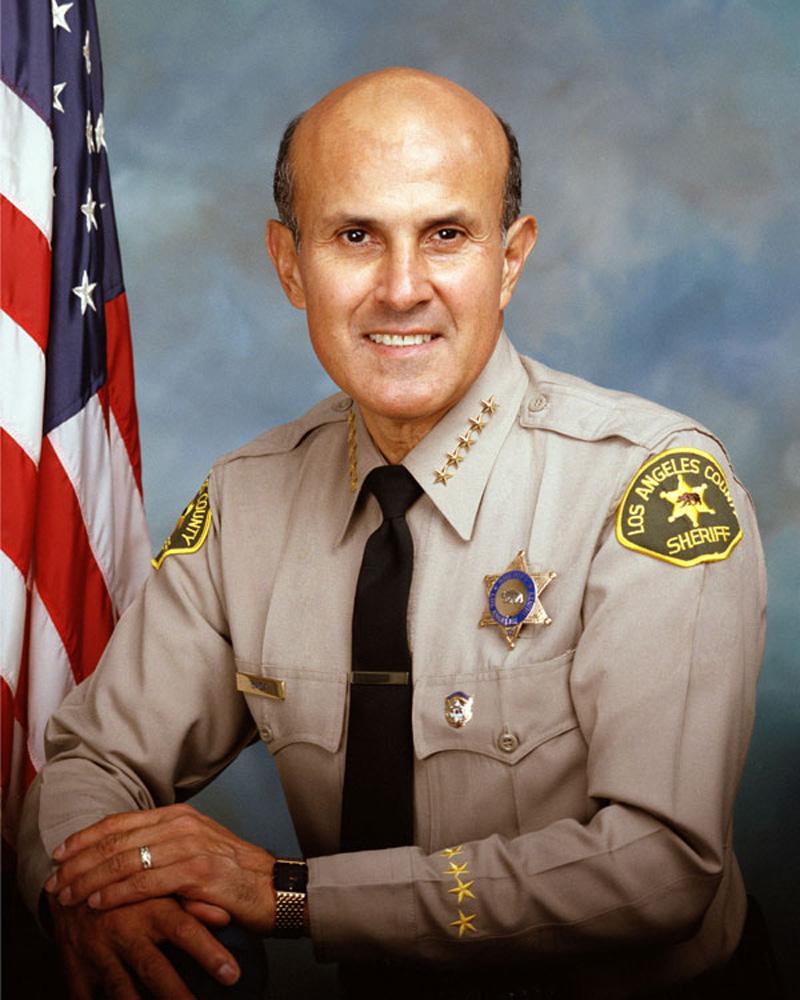
Silent Thunder and the Whistleblower
The DEA and LASD set up a special task force, dubbed “Operation Silent Thunder,” in 1999-2000. Lieutenant Ron L. Shreves supervised the special task force, whose purpose was to locate and eradicate corruption within law enforcement while dealing with criminal organizations that primarily traded in meth and weapons in the Los Angeles and Antelope Valley areas. Sheriff’s Deputy Darren Hager was appointed as the LASD liaison for Silent Thunder.
During this joint DEA task force with the LASD, Deputy Hager received information from LASD Homicide Detective Larry Brandenburg that “dirty deputies” who protected criminals in the Antelope Valley may have been involved in the murder of Deputy Jonathan Aujay.
Hager brought information to his command staff that a felony suspect was willing to provide the names of several methamphetamine dealers in the Antelope Valley in exchange for leniency. However, Assistant Sheriff Larry Waldie specifically ordered Hager and Silent Thunder, on March 23, 2000, not to look into deputy wrongdoing or Aujay’s disappearance.
Any information concerning Aujay was to be passed on to the Homicide Bureau and Detective Brandenburg.
Hager reported to Lieutenant Shreves. The DEA task force followed federal drug enforcement protocol and obtained information from cooperating sources and, as the investigation continued, obtained information through corroborating sources. The DEA task force also filed warrants and federal wiretap applications. The DEA task force made hundreds of arrests.
During the investigation, Hager asked informants about Deputy Aujay. The informants told him “Aujay was killed because he discovered a methamphetamine lab while out on a long-distance run,” and that “Deputy Richard Engels was at the methamphetamine lab when Aujay was killed.” Hager’s informants also linked Engels with Tom Hinkle, the kingpin drug manufacturer.
Darren Hager seemed adamant to get to the bottom and to find out the truth. Convinced he was being taken seriously by fellow deputies and his superiors, he prepared a report for the chain of command. The report disclosed information the DEA task force had received regarding Aujay’s disappearance and revealed information linking Engels to Hinkle and Aujay’s disappearance.
But Hager’s efforts and goodwill would soon blow up in his face.
As Hager followed orders and submitted his report, Detective Larry Brandenburg continued the homicide case of Aujay. Brandenburg was convinced Jonathan Aujay was murdered when he discovered a meth lab adjacent to the Devil’s Punchbowl park. However, when Detective Brandenburg tried to obtain a search warrant for Deputy Richard Engels and Tom Hinkle, his boss at the Homicide Bureau, Captain Frank Merriman, stopped him cold. Brandenburg was dismissed from the homicide case and replaced with Sergeant Joe Holmes.
Hager struggled to continue as an undercover officer for Silent Thunder after discovering that confidential information from his investigation was being leaked to the Sheriff’s Department and local drug dealers. An informant revealed that Deputy Richard Engels had warned a drug dealer about an upcoming law enforcement operation, compromising Hager’s efforts.
Hager faced death threats from his LASD co-workers, including from Deputy Engels, who threatened to kill him or end his career. Whenever he requested backup during arrests, deputies close to Engels—those who had threatened him—were always sent instead.
When a suspect provided information about Deputy Engels, Hager realized the need to protect the informant. However, each time he called for backup, Deputy Engels was dispatched. During one instance at the Palmdale Sheriff’s Department, a responding sergeant laughed when Hager specifically requested another deputy.
The newly appointed Homicide Sergeant Joe Holmes would go on to discredit Hager’s investigation, his methods and reports. It turned into an internal affairs case. The charge: Daren Hager had ‘falsely reported wiretapped conversations with informants’. A resignation letter followed soon. It read: “Daren Hager conducted a personnel investigation regarding Deputy Richard Engels and recklessly accused Deputy Engels of associating with drug dealers and having knowledge/involvement in the alleged murder of Deputy Jonathan Aujay.”
But Darren Hager fought back hard. He brought a whistleblower retaliation suit against the Los Angeles Sheriff’s Department.[3]
During the trial in September 2011[4] retired Deputy Russell Bailey, a 28-year veteran who retired in 2008, testified that he concluded the drug task force Silent Thunder in the Antelope Valley went beyond its scope when he learned he, himself, was a possible focus of the probe.
Russell Bailey stated he considers himself a friend of Deputy Rick Engels, who had advised him that his home might be the subject of a search warrant. Engels told him he received the information from a sheriff’s homicide investigator, Bailey said. It’s unclear who this homicide investigator is.
Russell Bailey and several other deputies from the Lancaster and Palmdale stations gathered to express their concerns to the county’s Office of Ombudsman after he discovered in 2000 that his home might soon be searched by members of a joint federal and local task force.”It was my belief that the investigation by Deputy Hager was out of control and it was affecting all of our lives greatly.”
Sheriff’s homicide detective Larry Brandenburg testified that he believed Deputy Richard Engels warned meth-makers about pending drug raids. Brandenburg said he prepared an affidavit for a search warrant of Engel’s financial and phone records.
Brandenburg testified he received little support from his boss, Capt. Frank Merriman, who believed Aujay had killed himself and warned him not to take his conclusions concerning Richard Engels to a judge.
Hager’s attorney, Richard Love,said another homicide bureau member, Joseph Holmes, then took over the case and found no wrongdoing by Richard Engels and concluded Aujay likely committed suicide.
Love criticized Sergeant Joe Holmes’ conclusions and said any possible criminal prosecution concerning how Aujay vanished would be difficult because the case has been “tainted” by the detective’s findings. “Darren Hager’s reputation has been destroyed,” Love said. “He can’t get a job. He was fired for something he never did.”
In the closing arguments Hager’s attorney said: “The department destroyed him so they could bury the Richard Engels and Jonathan Aujay issue once and for all,”
But lawyer Thomas Hurrell, on behalf of LA County, said Aujay’s death had nothing to do with the case.
In 2014 the jury returned a special verdict in Hager’s favor, awarding him $4,506,015 in lost earnings and non-economic damages. Even though he won, it must have been a bittersweet victory, his reputation having been damaged.
Deputy Engels has never been charged nor has his alleged network of fellow deputies who reportedly aided him and the criminal networks.
The protection “racket” within the chain of command seems to have run far and wide.
The people who were arrested by DEA and LASD during their Silent Thunder task force all served federal prison time, including Tom Hinkle.
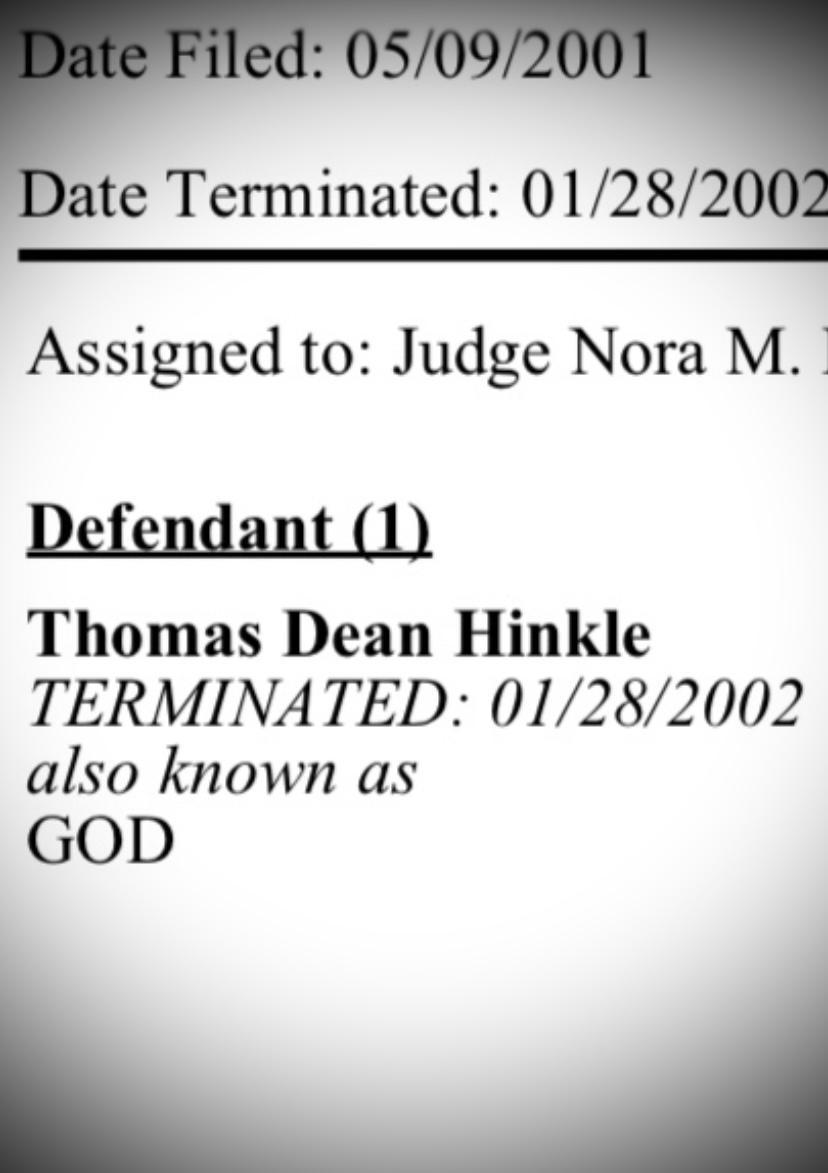
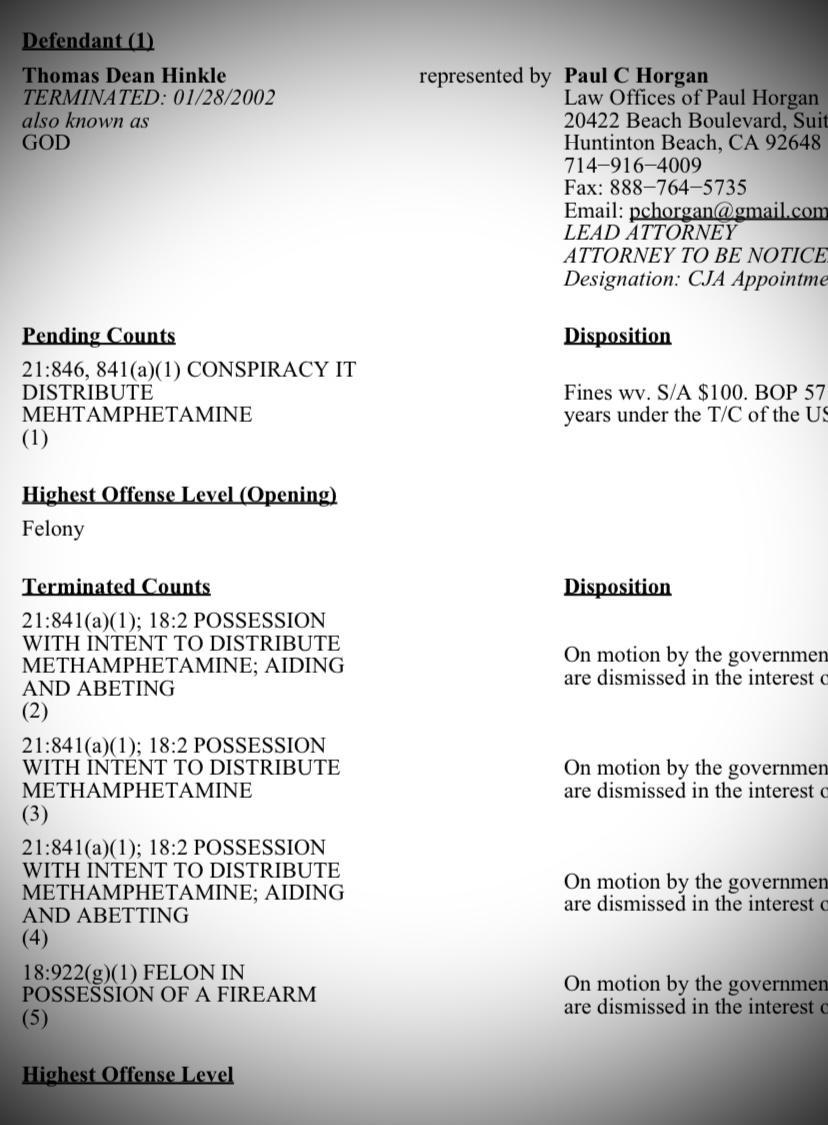
Thomas Dean Hinkle, also known as “GOD,” pleaded guilty to conspiracy to distribute methamphetamine. All other counts, like possession with intent to distribute methamphetamine; aiding and abetting, possession with intent to distribute methamphetamine, aiding and abetting, and possession of a firearm, were dismissed in “the interest of justice” upon a motion by the government.
Compared to the severity of his criminal acts, he walked back through the prison gate as a free man in 57 months.
“He served an ‘inappropriately’ short sentence,” Bauer says. “All the federal indictments went to trial with the relieved of duty Darren Hager as the prime witness, despite his destroyed reputation. Hinkle’s prosecution was interfered with by Sergeant Joe Holmes, who attended proffer sessions and somehow influenced the U.S. Attorney prosecutors to reduce the amount of drugs falsely. This all occurred while Cooley was dismissing local charges.”
Bauer refers to Steve Cooley, the former Los Angeles District Attorney who was elected in 2000 in a landslide victory. He made history by serving as DA for three consecutive terms until 2012.
A documented “reject” letter from the District Attorney’s office indicates that charges against DEA task force local arrestees were dismissed.
According to Bauer it is reported that his staff obstructed numerous local prosecutions of Silent Thunder arrestees who were referred by Hager and Lieutenant Shreves for state prosecution instead of federal drug charges. “This situation arose from accusations that Hager was not truthful and was an unreliable witness, claims reportedly instigated by Homicide Sergeant Joe Holmes and his Captain, Frank Merriman, likely under the direction of Sheriff Lee Baca, who was later convicted of obstruction of justice.”
Mr. Cooley may hold an opinion regarding the termination and trial of Darren Hager. An effort was made to schedule a phone conversation with Steve Cooley. The goal was to give him an opportunity to explain his work as District Attorney during the Hager trial and to comment on the Jonathan Aujay case. However, Mr. Cooley was hesitant and responded in an email Q&A instead:”I have no recollection of the Aujay case.”
Upon the question if he could recall the prosecution of Thomas Dean Hinkle, aka God, the Silent Thunder taskforce and Darren Hager’s case against the LASD, Cooley responded:”I do not recall that case. Do you have the name of the prosecutor?” And:”That was a federal case. LA DAO would have nothing to do with that.” When mentioning that the federal case of Thomas Dean Hinkle was related to the joint taskforce of LASD and the DEA who referred their arrestees for State prosecution, Mr. Cooley:”I have no recollection whatsoever. I never heard of that taskforce.”
Steve Cooley doesn’t recall the whistleblower case of Darren Hager against the LASD either.
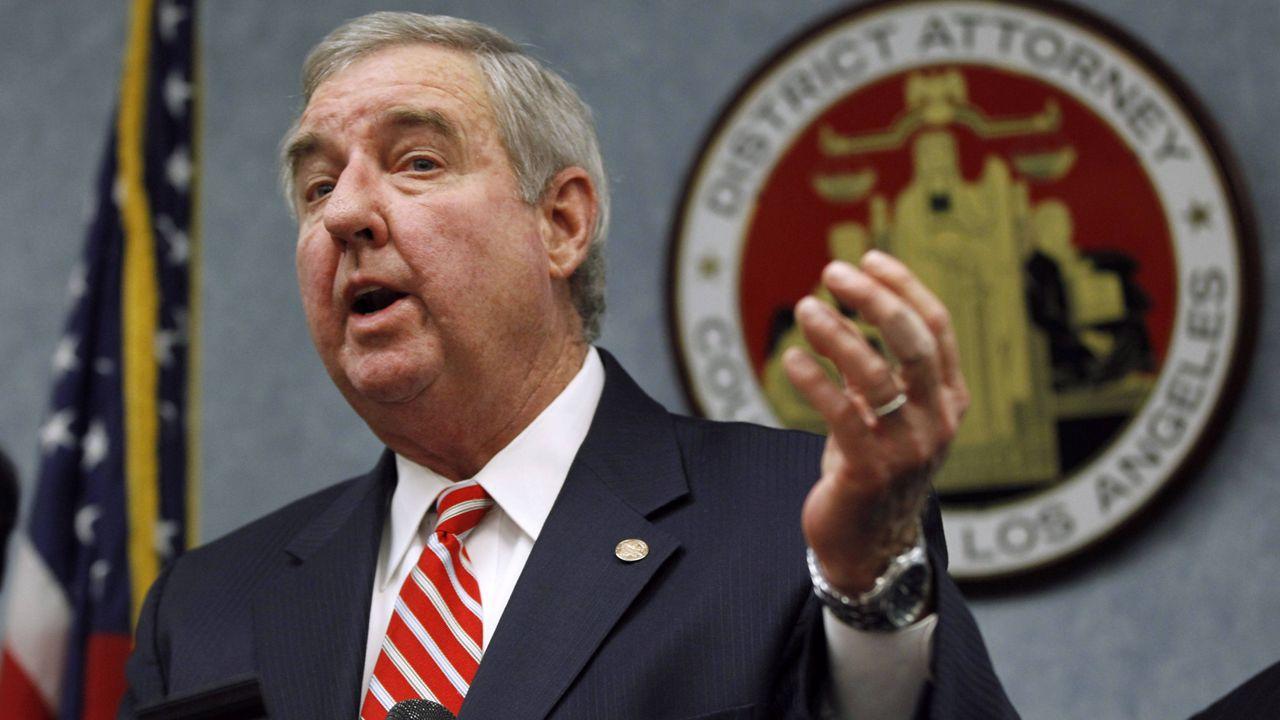
During his work for Operation Silent Thunder, Darren Hager did not come across any questions about Gary Devore’s death. He did mention that tow yards in the area were under surveillance by the DEA. One tow yard specifically was very near the crash site of Devore’s truck and was used by the CHP during the recovery and examination. This was Clark and Howard Towing in Palmdale.
The California Highway Patrol produced a detailed 158-page investigative report on the recovery of Devore’s car and skeleton. The investigative team comprised 44 personnel who were on the scene that day. It was a multi-agency effort. The CHP concluded that Devore must have made a U-turn on Highway 14 when the road was blocked for an unknown police felony stop. Devore then drove northbound against traffic and crashed into the water.
Critical report missing
After reviewing the filed coroner reports and the detailed California Highway Patrol report with the author of this article, Mike Bauer points out that an essential report is missing: a CHP180 report that should have been signed off along with the LASD homicide and CHP reports.
The CHP180 report is critical, because it pertains to the storage of a vehicle and proves the condition of the vehicle. This report is used by both CHP and LASD. This form must be signed and filed by the investigative parties as well as the involved tow company, in order to prevent theft of both the vehicle and its contents.
Gary Devore always carried a .38 Colt. Both his gun and laptop went missing after LASD divers recovered his truck from the aqueduct.
The LASD Records Bureau is currently working to locate the homicide report on Gary Devore; however, the CHP180 report is missing, possibly due to records purge or because it was never filed in the first place.
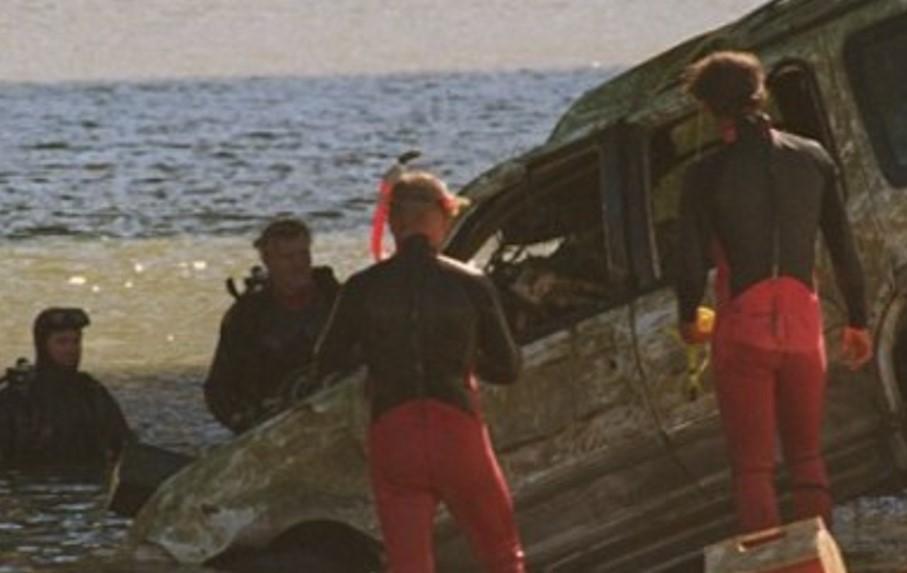
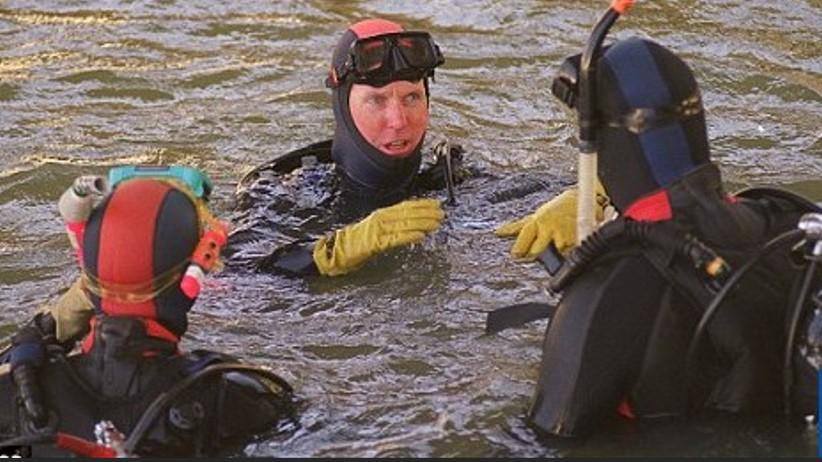
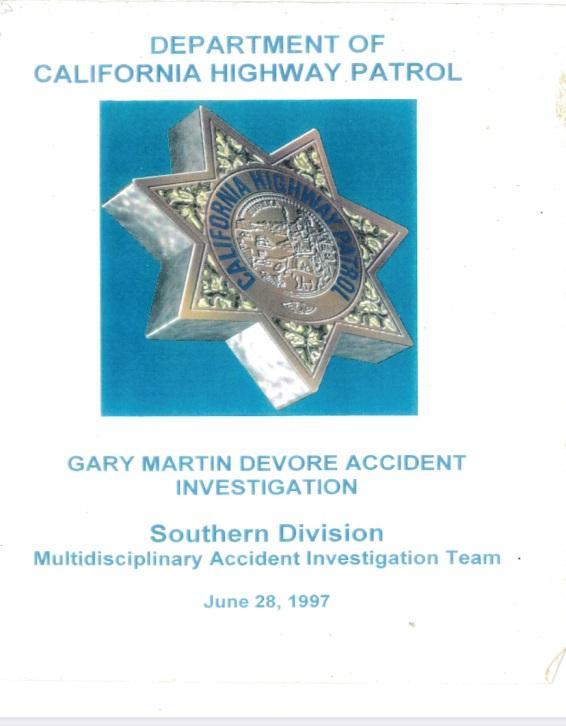
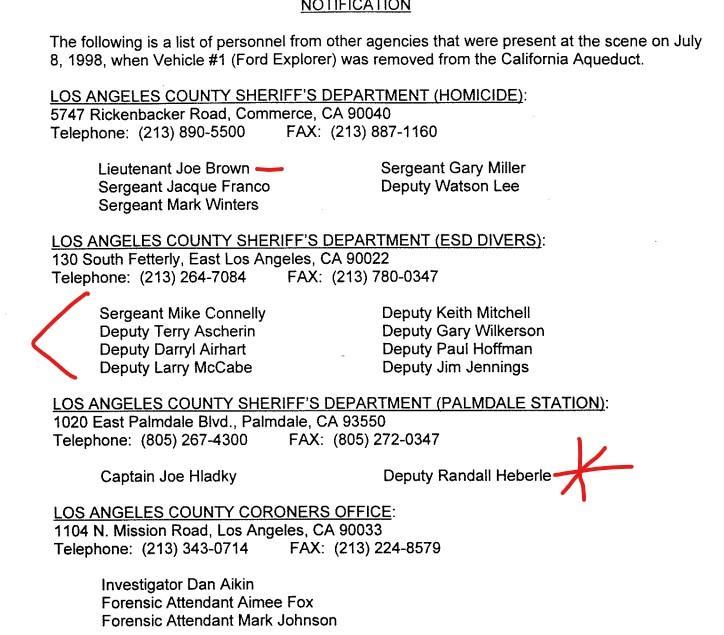
The name of Randall Heberle in the CHP report is incorrect. It is in fact Randell J Heberle, one of the deputies involved in this multi-agency recovery of Gary Devore and his truck. Randell aka Randy was Deputy at Palmdale Station. Weeks before, Heberle was one of the first deputies who was looking for the missing Jonathan Aujay in the Devil’s Punchbowl Park.
Heberle had made a public statement that he had spotted a .38 Smith and Wesson on the console of Aujay’s white Ford truck, which to him was worrying.
It has yet to be uncovered to what extent Randell Heberle was part of Deputy Richard Engels’ close-knit circle.
On September 13th 2000 two convenience store employees were killed in Palmdale. Authorities identified the victims as Phillip Privett Jr., 30, and the owner’s son, the 18-year old Majdy Nasry Haddad. The store was Vic’s F&M Market, across from the Clark and Howard tow yard. The first deputy on the scene was Randell Heberle. There were no suspects.
Deputy Jonathan Aujay disappeared before the start of Operation Silent Thunder. Interestingly, when Aujay transitioned from sharpshooter to canine handler, and as he grew closer to his police dog Bosco, he appeared to have set the dog up for drug detection training. A dog training manual for detecting drugs was later found among his personal belongings after his disappearance.
Was Aujay aware of deputies colluding with the Hinkle organization and other crime networks with clandestine labs that were responsible for kidnappings and murders of witnesses and people who passed through the area?
Theory building, conspiracy and truth
Cold cases can be emotionally demanding for researchers as well as professional detectives and relatives who have lived in limbo for so long, not knowing any answers. Persistence is key, but also the quality of information, and training in deception detection. Building and proving theories requires a long breath.
Academic Matthew Alford, who teaches conflict and media at the University of Bath in the UK, wrote a book about his experiences trying to find out what happened to Gary Devore and why.
“When I began investigating Gary Devore’s disappearance, I immersed myself in available information, which meant I lived and breathed the case for many years. I subsequently investigated several crimes and conspiracies. I worked in a small team to show that federal authorities had secretly exercised control over thousands of film scripts. I was less successful finding a woman who was missing—presumed dead—though we were able to rule out some burial spots. I learned that while it’s important to know all the context, it’s also vital to identify the weak spot—the parts of a case that are easiest to falsify. For instance, do time constraints make a particular theory impossible? Sherlock Holmes famously said, ‘When you have eliminated the impossible, whatever remains, however improbable, must be the truth.’ This is a good way to avoid drifting down innumerable rabbit holes. But, of course, it’s easier said than done, especially when the case may be marked by deception even at a systematic level. Sherlock also acknowledged that detective work requires creativity as well as logic: ‘We balance probabilities and choose the most likely. It is the scientific use of the imagination.’ Ultimately, of course, it’s also important to know when and how to let a case go.”
According to Mike Bauer, who has been living with cold cases for decades, it is important to dig into the alleged perpetrator’s personal life, to find out as much detail which is fundamental to building theories. “I always say build theories and then prove that they are wrong or right.”
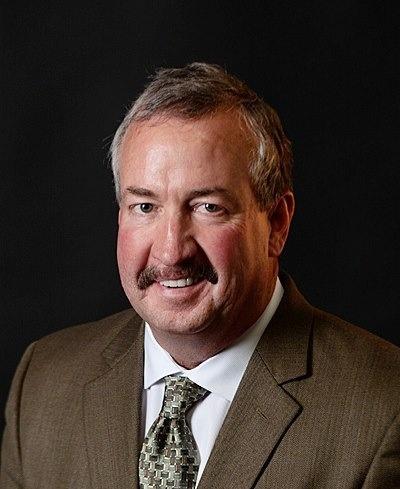
Bauer continues with his investigations to prove theories as he collects data and interviews suspects. As part of investigations, detection of deception is key. Richard Whitehead, a subject matter expert, is skilled in forensic detection deception. He uses statement analysis.
“Polygraph testing is still used, though science has proven that statement analysis is far more accurate than a polygraph test.”
This technique was developed by Avinoam Sapir as a discipline that combines linguistics, psychology and criminology.
The basics of a deception-detection technique like polygraph testing picks up changes in heart rate. Statement analysis picks up these changes through verbal and psychological cues in the written or spoken word.
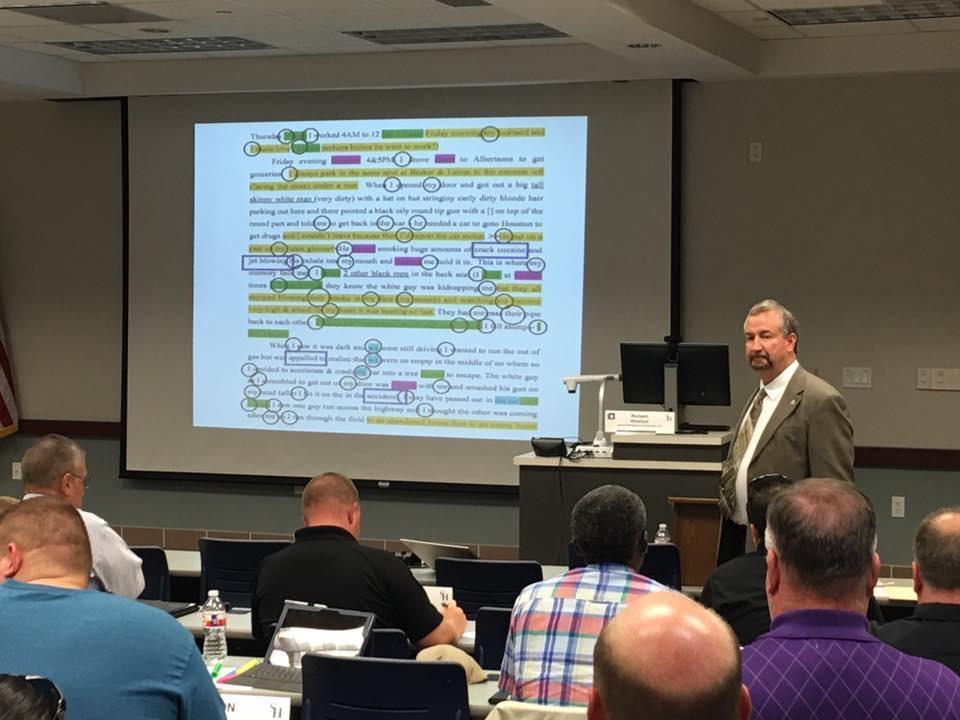
Whitehead started his career in law enforcement as a military police officer in 1977 and continued his career at a police department in the Houston area, and the Austin Sheriff’s Department. As a commander at the Travis County Sheriff’s Office, he attended the FBI National Academy. The FBI classes were extensive. It was then that he became inspired by statement analysis. He would teach the deception-detection technique to his officers at the Major Crimes Division and set up a consulting company.
Whitehead finds that statement analysis is very beneficial, as the technique leans into the linguistics and psychological cues in the words and word choice that unveil the mental state of the subject, which could reveal deception, hidden information, or even an “embedded” confession to a crime. “It gives the investigative officer a huge advantage of detecting flags that could reveal holes in a story the person is telling you. A person or subject may want to convince the detective by giving extraneous information, information that is irrelevant to the case.”
“When I do the analysis, I’m free of any information beforehand. I prefer not to know anything about cases before analysis but that’s not always possible. I must analyze the words without any bias. After that initial stage of analyzing the first statement, I ask law enforcement to provide me with the case details, their theory.”
Statement analysis plays a part in theory building because it proves the theory or rejects the theory.
Regarding corruption in police departments and collusion with criminal organizations, Whitehead says: “Man is wicked and selfish. The more power, the greater the desire or need to keep that power. There is a fear of losing that power, of being exposed. Speaking of exposure: when you read a first statement or hear someone’s first statement, the words they choose offer clues that could indicate a fear of being exposed. It’s the words they use and how they say things. People are attached to things, other people, or animals and when they feel threatened that these attachments may end up destroyed or when these attachments are harmed, it will evoke an emotional response in talking or writing. We call it requisite emotion.”
Statement analysis is integrated into the classic police Reid technique. It is part of the interview phase. Reid uses body language analysis, behavioral analysis, and interrogation techniques. Statement analysis is part of the interrogation phase. Whitehead says “I always advise detectives to use statement analysis before the interview.”
Currently, statement analysis is not admissible in court. But Whitehead is optimistic. He foresees that statement analysis will become admissible in a court of law to provide further insight into evidence for a particular theory and into the background of the investigation.
Statement analysis remains a way for Whitehead to believe he can contribute to humanity: “I always try to help. I advise former detectives who still work on cold cases to use statement analysis, or hire an analyst to go over the initial statements, which could give an insight and lead to different questions that could blow a hole in the story.”
Suspects, witnesses, and verbal or circumstantial evidence may have perished over time. Witnesses or informants may have lied to attract attention or may have been threatened or coerced to lie.
But nature never lies. Thanks to the human capacity to invent high-tech detection technology and the persistence of detectives and forensic experts there is hope for cold cases. The poppies will still grow over the grounds once touched by people who attempted to deceive and cover up clandestine graves. Mike Bauer remains stoic and persistent, hopeful even: “Somebody knows something. Always.”
This feature is dedicated to Gary Devore, Jonathan Aujay, Gary Webb, Michelle O’Keefe, Phillip Privett Jr., Majdy Nasry Haddad, and other unmentioned missing and murdered persons and all their loved ones.

This article is also dedicated to the rebellious reporter Evan Wright whose distinguished career involved feature writing for Rolling Stone magazine and an HBO documentary among other accomplishments.
Posey is considered by some a fraud who falsified his professional credentials. ↑
The section on Aujay on this page and next draws in part from Claire Martin, “The Deputy Who Dsiappeared,” Los Angeles Magazine, October 27, 2015. ↑
Hager v. County of Los Angeles ↑
City News trial reports September 2011 ↑
CovertAction Magazine is made possible by subscriptions, orders and donations from readers like you.
Blow the Whistle on U.S. Imperialism
Click the whistle and donate
When you donate to CovertAction Magazine, you are supporting investigative journalism. Your contributions go directly to supporting the development, production, editing, and dissemination of the Magazine.
CovertAction Magazine does not receive corporate or government sponsorship. Yet, we hold a steadfast commitment to providing compensation for writers, editorial and technical support. Your support helps facilitate this compensation as well as increase the caliber of this work.
Please make a donation by clicking on the donate logo above and enter the amount and your credit or debit card information.
CovertAction Institute, Inc. (CAI) is a 501(c)(3) non-profit organization and your gift is tax-deductible for federal income purposes. CAI’s tax-exempt ID number is 87-2461683.
We sincerely thank you for your support.
Disclaimer: The contents of this article are the sole responsibility of the author(s). CovertAction Institute, Inc. (CAI), including its Board of Directors (BD), Editorial Board (EB), Advisory Board (AB), staff, volunteers and its projects (including CovertAction Magazine) are not responsible for any inaccurate or incorrect statement in this article. This article also does not necessarily represent the views the BD, the EB, the AB, staff, volunteers, or any members of its projects.
Differing viewpoints: CAM publishes articles with differing viewpoints in an effort to nurture vibrant debate and thoughtful critical analysis. Feel free to comment on the articles in the comment section and/or send your letters to the Editors, which we will publish in the Letters column.
Copyrighted Material: This web site may contain copyrighted material the use of which has not always been specifically authorized by the copyright owner. As a not-for-profit charitable organization incorporated in the State of New York, we are making such material available in an effort to advance the understanding of humanity’s problems and hopefully to help find solutions for those problems. We believe this constitutes a ‘fair use’ of any such copyrighted material as provided for in section 107 of the US Copyright Law. You can read more about ‘fair use’ and US Copyright Law at the Legal Information Institute of Cornell Law School.
Republishing: CovertAction Magazine (CAM) grants permission to cross-post CAM articles on not-for-profit community internet sites as long as the source is acknowledged together with a hyperlink to the original CovertAction Magazine article. Also, kindly let us know at info@CovertActionMagazine.com. For publication of CAM articles in print or other forms including commercial internet sites, contact: info@CovertActionMagazine.com.
By using this site, you agree to these terms above.
About the Author

Mel Elorche is a screenwriter and journalist who lives in California.
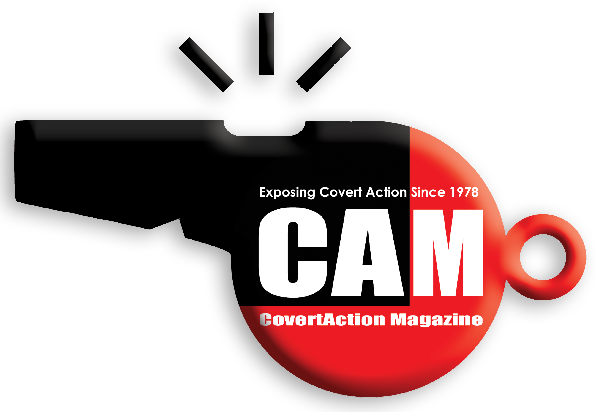
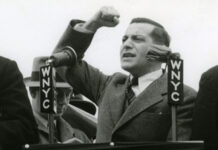








Thanks, Mel, for an exceptional and well-documented report. You are likely aware that one of the blockbuster revelations that Devore uncovered re: Panama was that Manuel Noriega had been running a Jeffry Epstein-type operation wherein CIA personnel in Panama (the CIA’s playground) were secretly filmed in sex acts, and Noriega apparently was blackmailing them. Guess we’ll never know how high-level the compromised CIA staff were. Likely the main reason for Bush’s 1998 invasion of Panama (“Operation Just Cause”).
For what it’s worth, I attended Gary Webb’s memorial service. Mike Ruppert gave the eulogy. It also happens that right after 9/11 happened I had contacted Ruppert and made arrangements for him to speak to a large audience in Sacramento. Which he did in February 2002. Therein lies another tale.